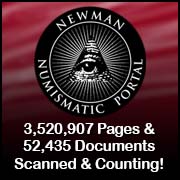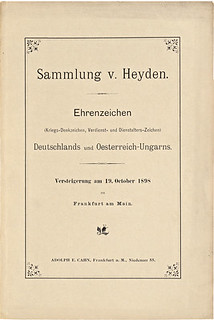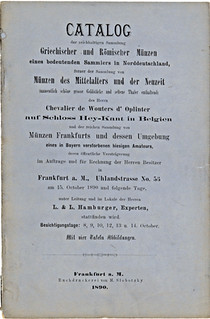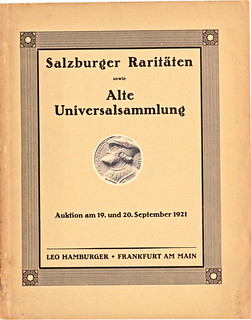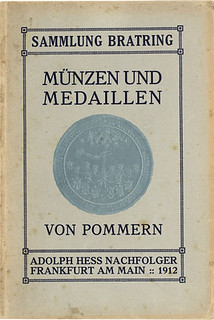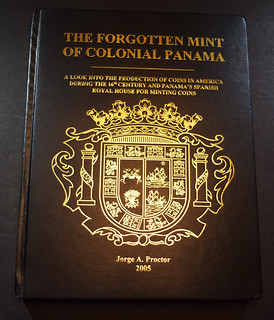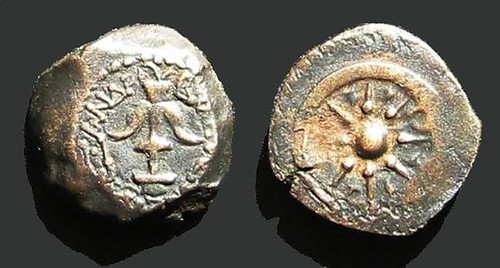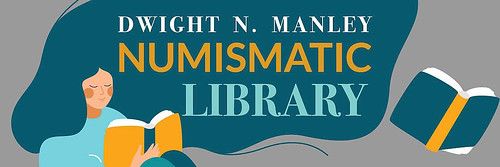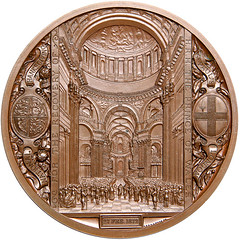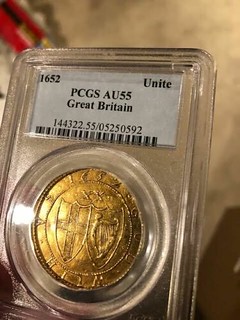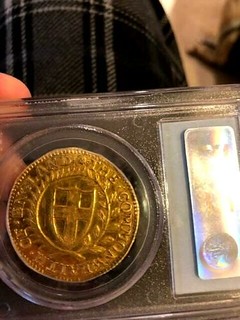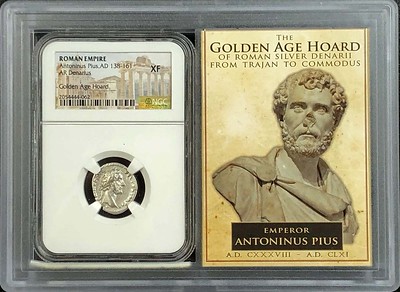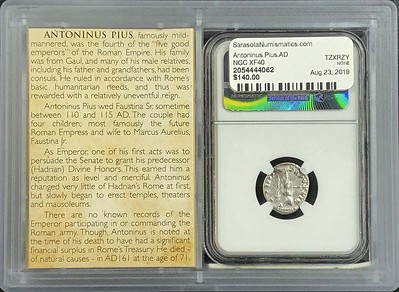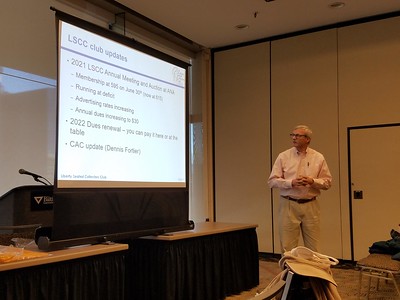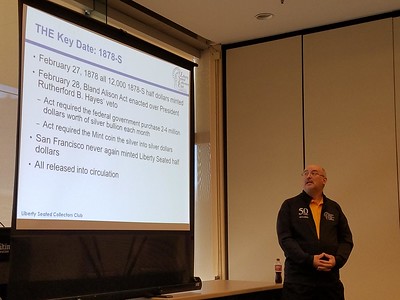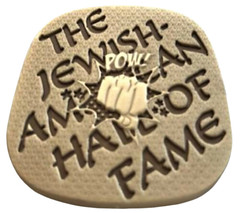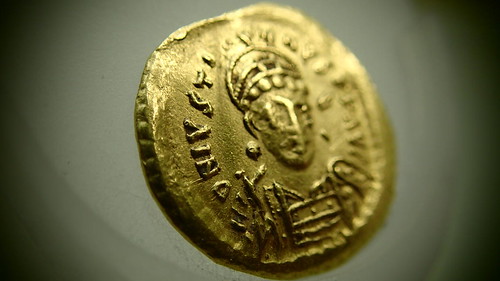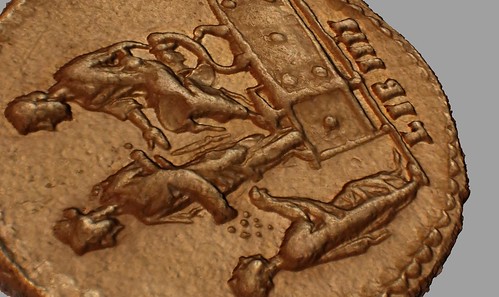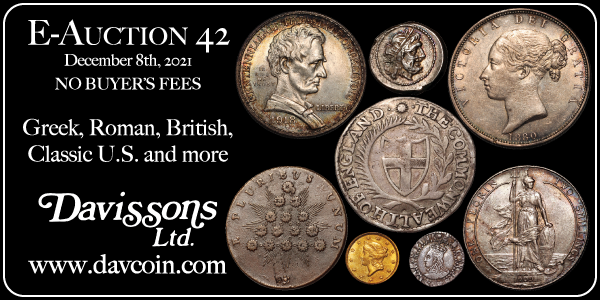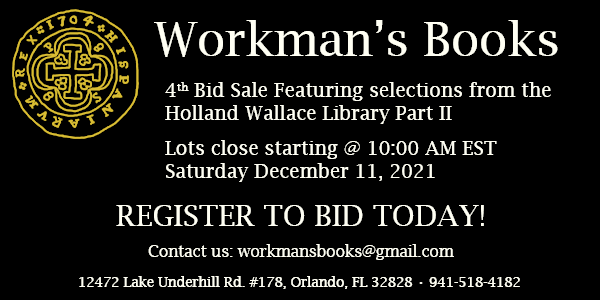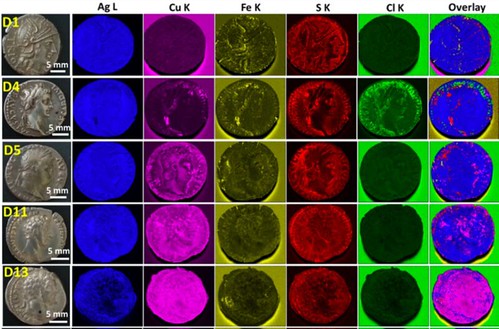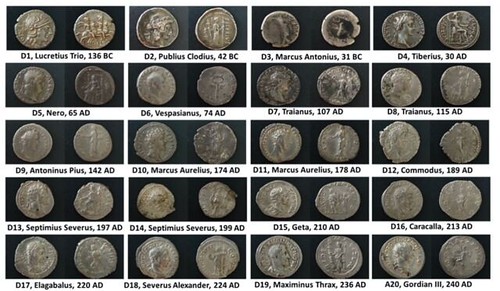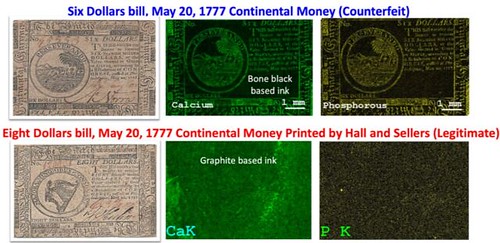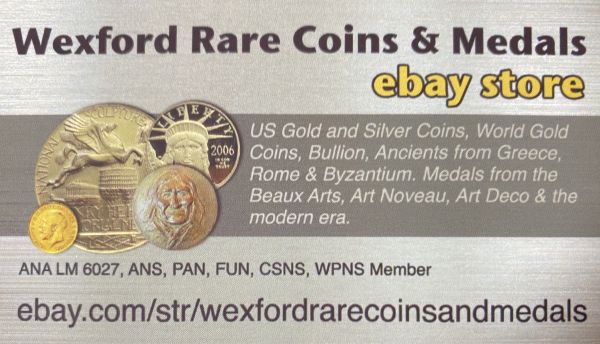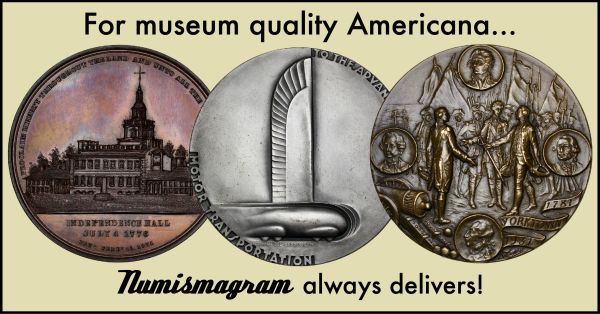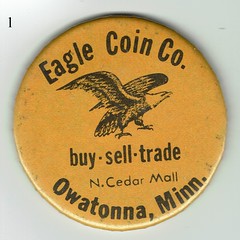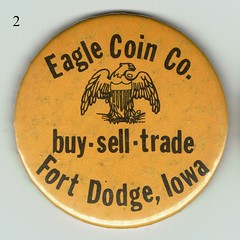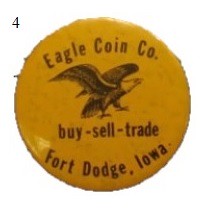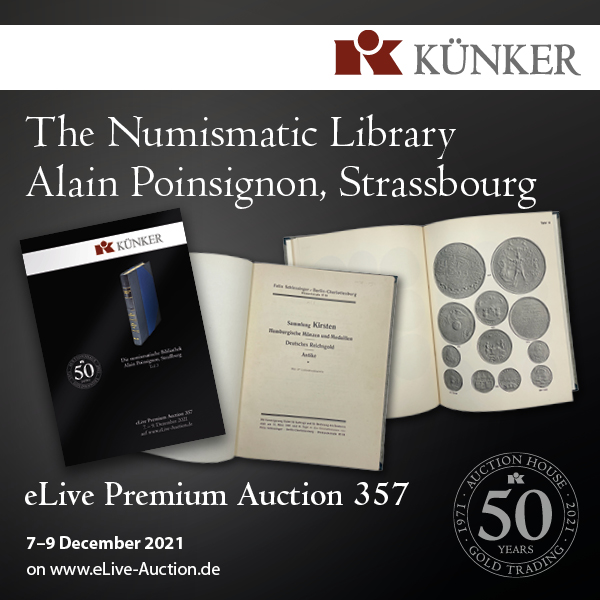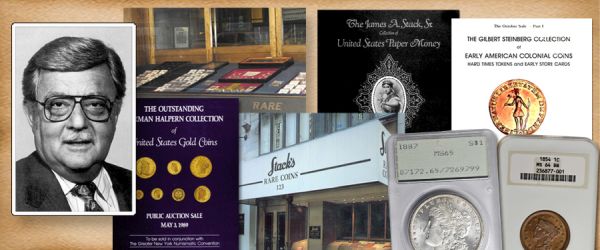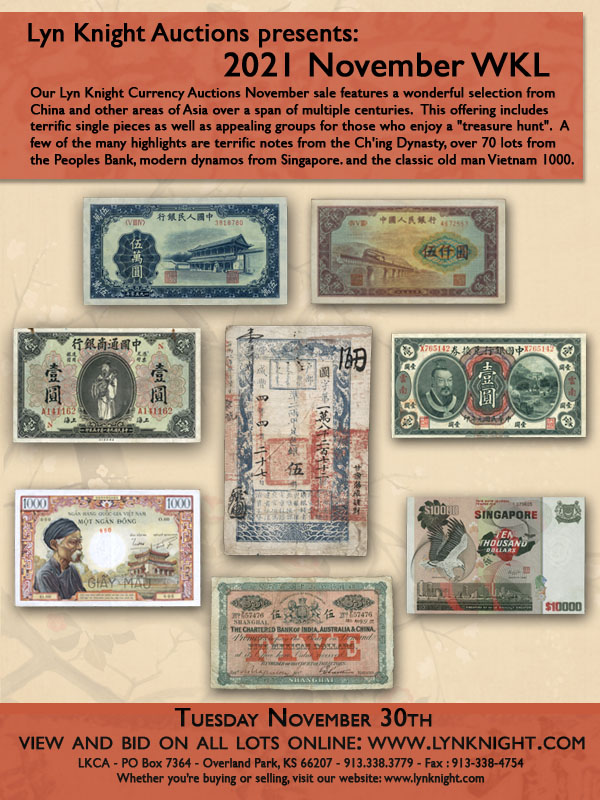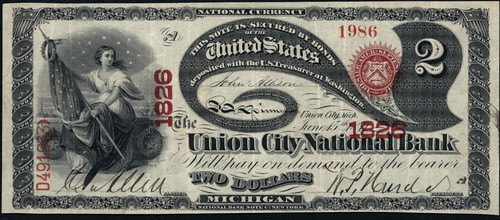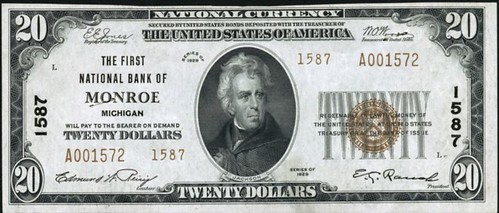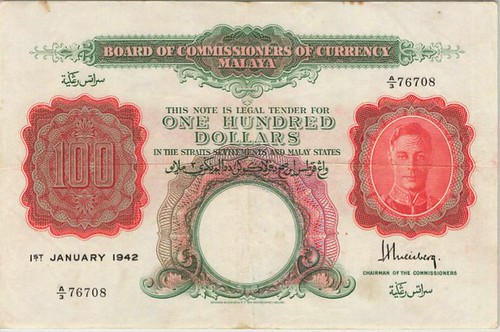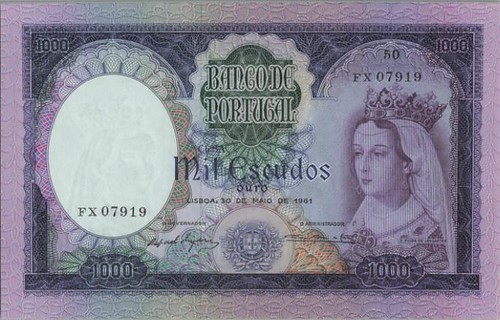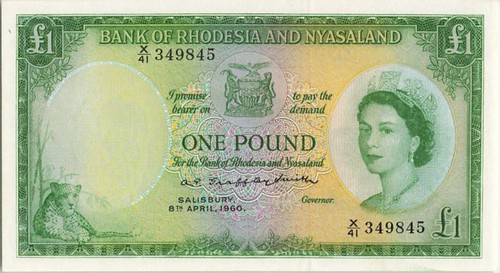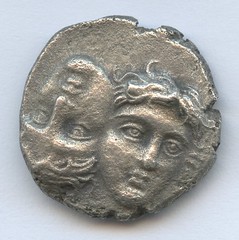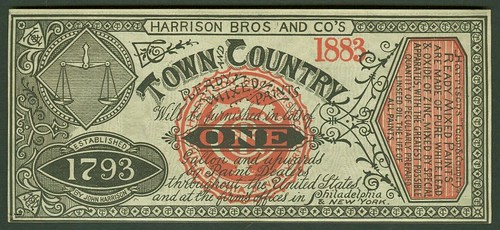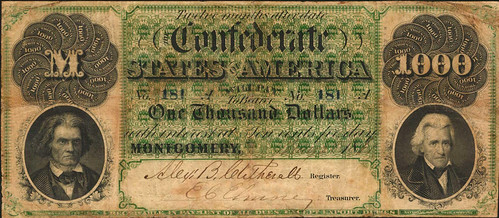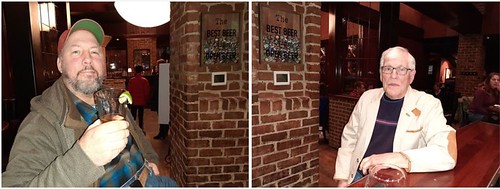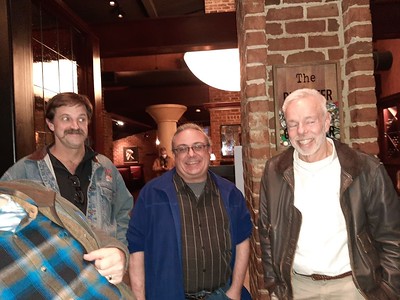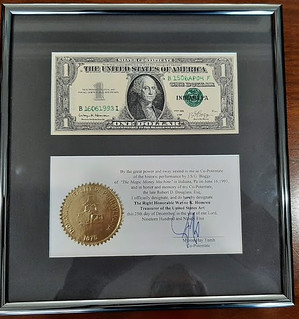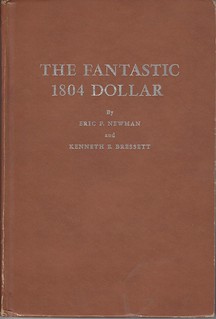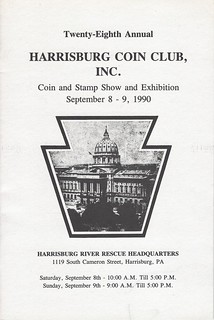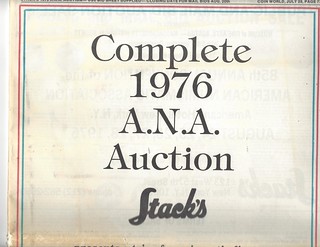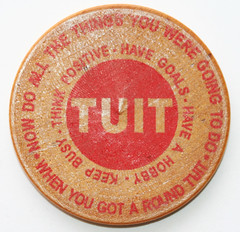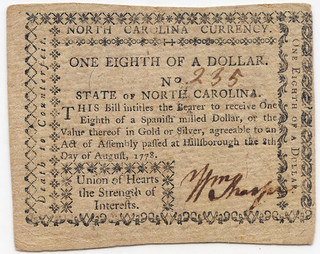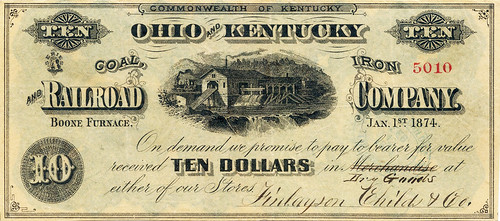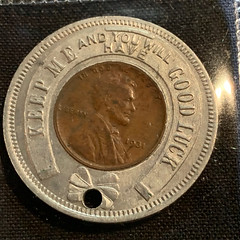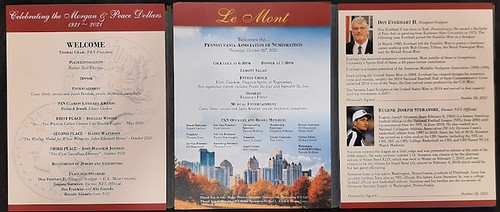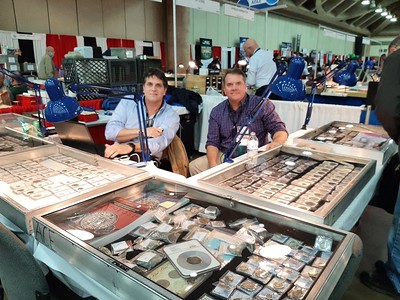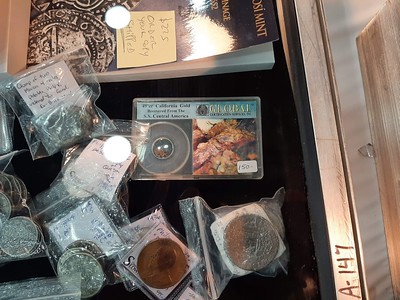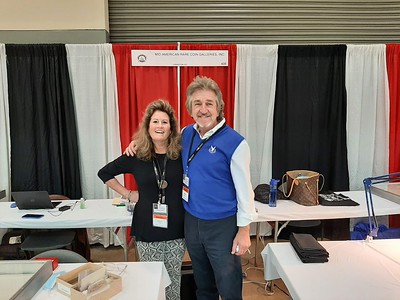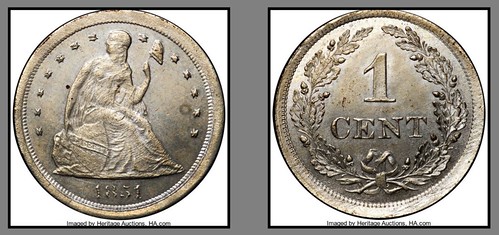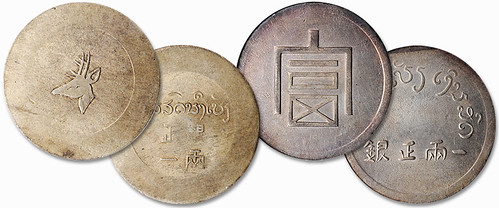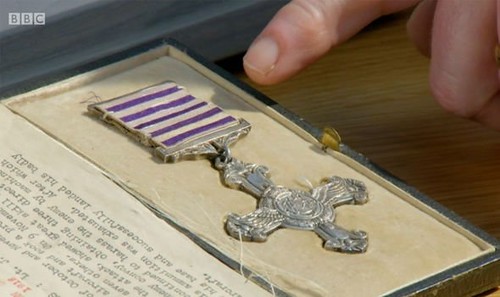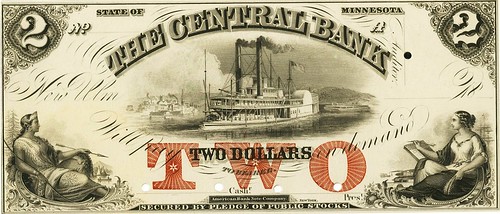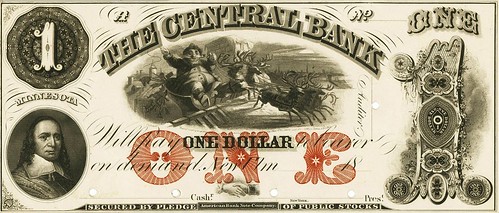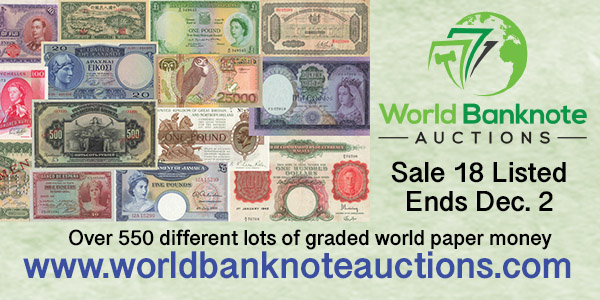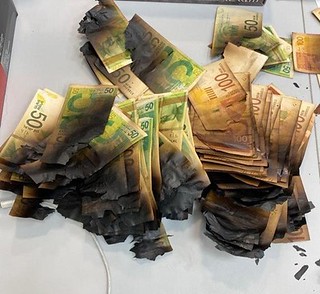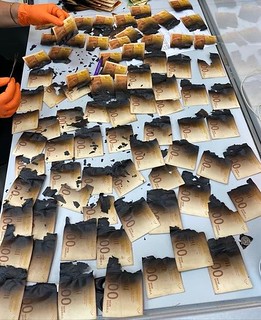
Visit our NBS Sponsors



About UsThe Numismatic Bibliomania Society is a non-profit association devoted to the study and enjoyment of numismatic literature. For more information please see our web site at coinbooks.org SubscriptionsThose wishing to become new E-Sylum subscribers (or wishing to Unsubscribe) can go to the following web page link MembershipThere is a membership application available on the web site Membership Application To join, print the application and return it with your check to the address printed on the application. Print/Digital membership is $40 to addresses in the U.S., and $60 elsewhere. A digital-only membership is available for $25. For those without web access, write to: Charles Heck, Treasurer AsylumFor Asylum mailing address changes and other membership questions, contact Chuck at this email address: treasurer@coinbooks.org SubmissionsTo submit items for publication in The E-Sylum, write to the Editor at this address: whomren@gmail.com BUY THE BOOK BEFORE THE COINSale CalendarWatch here for updates! |
- WAYNE'S WORDS: THE E-SYLUM NOVEMBER 21, 2021
- KÜNKER OFFERS POINSIGNON LIBRARY PART 3
- WORKMAN BOOKS DECEMBER 11, 2021 SALE
- BOOK PREVIEW: GUIDE TO BIBLICAL COINS 6TH ED.
- NEW BOOK: CATALOG OF BELGIAN NUMISMATICS 2022
- NEW PERIODICAL: HALF CRAZY
- ANA LIBRARY REOPENS FOR IN-PERSON SERVICES
- A THANKSGIVING THAT WASN'T
- VIDEO: RANDY'L TETON MODELS SACAGAWEA
- NOTES FROM E-SYLUM READERS: NOVEMBER 21, 2021
- NICKLE GALLERIES CREATES 3D COIN IMAGES
- X-RAY SPECTROSCOPY ROMAN COINS STUDY
- PHYSICIST WORKS TO FOIL COUNTERFEITERS
- PRINCETON SEEKS BYZANTINE CATALOGUER
- VOCABULARY TERM: GALVANO MEDAL
- ROBERT ARTHUR JOSLIN, SR. (1935-2005)
- HARVEY STACK'S NUMISMATIC FAMILY, PART 109
- SIR BROOK WATSON (1730-1807)
- BABY CAS PHYSICAL BITCOIN BRINGS $1.698M
- CLASSICAL NUMISMATIC GROUP TRITON XXV SALE
- DAN FREELAND MICHIGAN NATIONAL BANK NOTES
- WORLD BANKNOTE AUCTIONS LIVE SALE 18
- NUMISMATIC NUGGETS: NOVEMBER 21, 2021
- WAYNE'S NUMISMATIC DIARY: NOVEMBER 21, 2021
- THE LIBERTY SEATED CENT PATTERN
- A TAEL OF EMERGENCY CHINESE MONEY
- RARE WWI DISTINGUISHED FLYING CROSS MEDAL
- BANKNOTES OF NEW ULM, MINNESOTA
- ZIMBABWE HUSTLERS TRADE TATTERED US NOTES
- LOOSE CHANGE: NOVEMBER 21, 2021
- JERUSALEM WOMAN MICROWAVES RENT MONEY
Click here to read the thin version on the web
Click here to subscribe
Click here to access the complete archive
To comment or submit articles, reply to whomren@gmail.com
Content presented in The E-Sylum is not necessarily researched or independently fact-checked, and views expressed do not necessarily represent those of the Numismatic Bibliomania Society.
WAYNE'S WORDS: THE E-SYLUM NOVEMBER 21, 2021
 New subscribers this week include:
NBS members
Douglas Ward and Michael Fiori.
Welcome aboard! We now have 6,726 subscribers.
New subscribers this week include:
NBS members
Douglas Ward and Michael Fiori.
Welcome aboard! We now have 6,726 subscribers.
Thank you for reading The E-Sylum. If you enjoy it, please send me the email addresses of friends you think may enjoy it as well and I'll send them a subscription. Contact me at whomren@gmail.com anytime regarding your subscription, or questions, comments or suggestions about our content.
The Künker auction house has become a sponsor of NBS. Thank you for your support! Be sure to click on their ads and check out their great offerings.
This week we open with two numismatic literature sales, two new books, a new periodical, the reopening of the ANA Library, updates from the Newman Numismatic Portal, and more.
Other topics this week include science in numismatics, numismatic biographies, the "Baby Cas" physical bitcoin, auction previews, the Liberty Seated cent, Zimbabwe dollar hustlers, and what happens when you put money in a microwave.
To learn more about Alain Poinsignon, Biblical coins, the Thanksgiving that wasn't, Randy'L Teton, Story Vaults, 3D coin images, electrotypes, coin dealer Robert Arthur Joslin, Sr., Watson and the Shark, the Allen F. Lovejoy Collection of dimes, Michigan National Bank Notes, the $1000 Montgomery Note, and Bob Hendershott's Wooden Nickel, read on. Have a great week, everyone!
Wayne Homren
Editor, The E-Sylum

KÜNKER OFFERS POINSIGNON LIBRARY PART 3
The final part of the numismatic library of French coin dealer Alain Poinsignon will be sold in Künker's auction 357 in November. Here's the announcement. -Editor
We are pleased to present you the third and last part of the numismatic library Alain Poinsignon, Strasbourg.
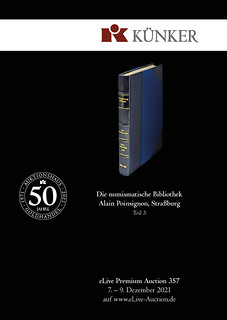 The Strasbourg coin dealer is known to many collectors around the world. He opened his first coin shop in 1974 in Mulhouse. In 1984, he moved to Strasbourg, where he managed a retail store called "Poinsignon Numismatique" for many decades. Alain Poinsignon is proud of the high standard of his coin determinations, for which he compiled an extensive library. With roughly 8,000 books, journals and 3,000 auction catalogs, his numismatic library is probably one of the most important specialized libraries in Europe in private hands.
The Strasbourg coin dealer is known to many collectors around the world. He opened his first coin shop in 1974 in Mulhouse. In 1984, he moved to Strasbourg, where he managed a retail store called "Poinsignon Numismatique" for many decades. Alain Poinsignon is proud of the high standard of his coin determinations, for which he compiled an extensive library. With roughly 8,000 books, journals and 3,000 auction catalogs, his numismatic library is probably one of the most important specialized libraries in Europe in private hands.
This part contains nearly 2,000 lot numbers with historical auction catalogs and fixed price lists. Included are all the great names in numismatics: from Adolph E. Cahn to L. and L. Hamburger to Felix Schlessinger to Henri Rolland in Paris to Jacques Schulman in Amsterdam to Sotheby, Wilkinson and Hodge in London.
Alain Poinsignon collected with precision, knowledge and passion historical auction catalogs of the 19th and early 20th century, as they are for every coin dealer of existential importance, if he cares about the provenance of important pieces. A bibliophile's delight awaits the bidder. Alain Poinsignon was himself a bibliophile in the best sense of the word and attached particular importance to proper binding.
It may be surprising that we have provided all lots of this auction with a quite low standard estimate, so that every bibliophile has the best possible chance to buy a publication.
The online auction takes place from 7-9 December 2021 at 5 p.m. on our eLive Auction platform.
Detlev Hölscher penned an article on the history of numismatic auction catalogs as a preface to the sale. Here's an excerpt. -Editor
The auction catalogues and fixed price lists form another (and at the same time the last) genre of numismatic literature in the library of Alain Poinsignon. Corresponding publications from the second half of the 19th century to about 1950, including isolated earlier lists, form the core of the collection to be auctioned here. These are mostly recorded in individual items.
In addition, Alain Poinsignon has also given us a selection of his more recent catalogue holdings, most of which we have integrated into our auction in bundles, sometimes in the form of closed series. It may come as a surprise that we have given each lot in this auction a very modest standard estimate, from which a hammer price of several or many times that amount should undoubtedly result from case to case. In our experience, however, especially for the 19th and early 20th century catalogues -- some of which were produced in small editions as commercial utility products in a simple paper quality -- as well as for certain special collection catalogues, the results in today's auctions are markedly different even for items in a similar state of preservation. For this reason, we have decided to give our extensive clientele the opportunity to establish the realistic market price for each lot.
With regard to the geographical origins of the collection, it should be noted that French publications are of course strongly represented here, as are German and Swiss publications. Austria and Italy are also present with relevant publications. British and US catalogues, on the other hand, are rather sparse here in view of the large number issued there.
Although these publications owe their origins to commercial considerations and not to scholarly research, they form an important source group in numismatics, which their editors as a rule carefully compiled taking into account the current state of publications of the time. They offer an insight into the coin market, the companies involved in it, as well as into the original owners of those collections that flowed back into the market. In particular, those auction catalogues that were furnished by their contemporaries with authentic handwritten entries of the hammer prices, the names of the buyers and, in the best case, even the names of the respective losing counterbidders, represent extremely meaningful and valuable testimonies -- for today's collectors, professional numismatists, and also for provenance research, which must peruse a more than 700-year history of modern coin collecting and numismatic collections.
The first documented auction, which among other things also included coins, took place in Leiden on 6 July 1599. It included objects from the movable estate of the writer, military officer and politician Philip St. Marnix, Lord of Sint-Adelgonde (* 1540 in Brussels, † 1598 in Leiden): especially the books from his library, but also paintings and both gold and silver coins. Of course, there were no exclusively coin dealers at that time, but jewellers and goldsmiths were also active in this field, trading not only in jewellery but also in collector coins. Early on, experts in coinage roamed the whole of Europe and parts of the Orient on behalf of aristocratic and bourgeois collectors, in search of rarities. The extent to which coin collecting was already widespread in Europe around the middle of the 16th century is documented in the travelogue of the printing entrepreneur, painter and scholar Hubert Goltzius (* 1526 in Venlo, † in Bruges). On his study trip through the Netherlands, Germany, France and Italy between 1556 and 1560, he saw no fewer than 950 coin collections.
Although interest in post-antiquity history increased steadily from the 16th century onwards, coin collectors still concentrated almost exclusively on the ancient world, predominantly on the Roman era, until the 17th century. Only a few outsiders had previously dealt with medieval or even contemporary coins. Now these objects also came into the scope of collectors and authors. Thus, as early as 1592, the mayor of Göttingen, Germany, Tileman Friese, wrote the first general guide for those interested in coinage. In addition to an overview of the history of coins in antiquity and the German Middle Ages, this work contains, among other things, a discussion of German and non-German coin types.
By the 17th and 18th centuries, numismatic research had advanced yet further. The holdings of the important princely collections continued to grow. During this period, coins and medals began to be separated from the heterogeneous cabinets of rarities and kept as independent collections. During the reign of Louis XIV (1643-1715), the coin collection of the French royal house developed into the most important of its time thanks to the monarch's great numismatic interest. Coin collecting had become a veritable fashion at almost all the courts of Europe. In the 18th century, coin collecting had also established itself among broad circles of the middle classes as an erudite pastime. Merchants and bankers, such as Mayer Amschel Rothschild (1743-1812), founder of the Frankfurt banking house of the same name, also became coin dealers.
Coin auctions were not at all uncommon in the 18th century. Collectors could inform themselves about the range of goods on offer through printed auction catalogues; interested parties from outside the city had the opportunity to be represented at the auction by commission agents. The number of numismatic publications now increased considerably. The first purely numismatic journal was the Wöchentliche Historische Münz-Belustigung
, edited by Johann David Köhler and published in Nuremberg from 1729 to 1750/56. This periodical was intended as a popular medium for collectors and those interested in coinage, and contained mainly historically-oriented confabulation about selected coins and medals. It also contained notices of upcoming auctions, advertisements for newly published coin-related publications, sometimes short reviews, and even lists of coins and medals offered for sale by private individuals or merchants.
Several bibliographies take into account the great professional importance of numismatic auction catalogues and stock lists. The compilation of the holdings of the Fitzwilliam Museum library provides a useful, though not entirely complete, index (T[heodore]. V. Buttrey [Jr.], List of Numismatic Auction Catalogues and Fixed Price Lists, 2 vols. n.p. 2014) of related publications. The work of the art historian and collector Frits Lugt, which lists catalogues of art auctions (including coin auctions) on a large scale from the period 1625 to 1925 and beyond, should also be mentioned in this context (Frits Lugt, Répertoire des catalogues de ventes publiques, intéressant l'art ou ... monnaies médailles, camées, intailles, armes, instruments, curiosités naturelles, etc. 4 vols., The Hague 1937-1984). Further relevant bibliographies exist for the numismatic auction catalogues of certain countries, such as for the USA, for Denmark and Norway, and for Great Britain.
In the case of France: As far as I know, there is no concise compilation of French coin auctions, only a compilation of those auctions in which experts for the House of Bourgey were involved -- which also has some gaps, as some smaller auctions are missing from it (Sabine Bourgey/Georges Depeyrot, Collections Numismatiques. La République Romaine, 1988).
Detlef Tietjen compiled a list of German firms with the catalogue of his Auction 20 of 10 November 1976, which contained the extensive catalogue holdings from the firm library of the Münzenhandlung Richard Gaettens Jr. With this much-acclaimed work, the author introduced a numbering system for the German auction catalogues and stock lists published from 1871 to 1945, based on the respective companies. In addition, he resolved the names of collectors, which had been concealed or abbreviated in ambiguous form by the auction houses of the time for reasons of discretion.
John Spring published a book on the auction catalogues from 1880 to 1980 which contained mainly ancient coins. The book not only lists them bibliographically, but also outlines the history of the coin trading companies involved and contains biographies of their last owners at the time (John Spring, Ancient Coin Auction Catalogues 1880-1990, London 2009). Our modern conception of the auction catalogue was based on Spring's work. Thus, I have dealt with the coin dealers and auction companies represented in our auction catalogue and also carried out research on the collectors listed there, who are sometimes known only by name; I have set down my conclusions drawn from this research, in particular regarding the persons and companies -- some of which have already fallen into oblivion -- who contributed a building block to the history of numismatics simply by building up collections and documenting them in the commercial catalogues.
To read the complete article, see:
Coin Collecting – An immaterial cultural Inheritance: Private citizens, dealers and their commercial catalogues
(https://www.kuenker.de/en/information/presseinformationen/aktuelle-mitteilungen/391)
To download the catalog as a .pdf, see:
https://www.kuenker.de/data/kataloge/Kuenker357_Katalog_web.pdf
To bid online, see:
https://elive-auction.de/auktionen/94/lose
THE BOOK BAZARRE
WORKMAN BOOKS DECEMBER 11, 2021 SALE
Alan Workman's fourth literature sale is now online, featuring items from the numismatic library of world coin expert Holland Wallace. Here's the press release and some selected lots that caught my eye. To get on his mailing list, go to: https://eepurl.com/r3muv . -Editor
Workman's Books is conducting its fourth bid sale of rare, vintage, and out-of-print numismatic books, auction catalogs, dealer fixed price lists, and numismatic journals from the collection of long-time dealer, collector, and author, Holland Wallace. The sale will close at 10:00 AM on December 11, 2021 and will include 612 lots of rare, vintage, out-of-print, and rarely seen items on the United States, Canada, Mexico, Central & South America, Europe, Portugal, Spain, the Middle East, Asia, and Spanish colonial numismatics. Included in this sale are important works and sales by Barriga-Villalba, Bruns, Burzio, Calico, Cayon, Christie's, Christensen, Craig, Douglas, Elder, Gilboy, Glendining, Grove, Herrera, Lazaro, Low, Medina, Ponterio, Pradeau, Pridmore, Prober, Schulman, Sellschopp, Shuhart, Sotheby's, Stack's, Superior, Woodward, and many others.
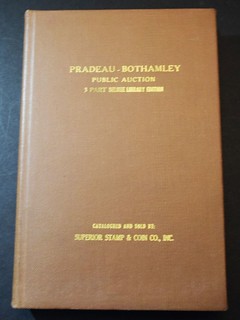 This bid sale is being held through the online venue iCollector, and all registrations, approvals, and bids will be handled there. For this bid sale the lots will be closing on a timed interval with extensions of 1 minute for any bids placed within 1 minute of closing. If you already have an iCollector account, you still must "GET APPROVED" to bid for each sale by entering and confirming your information for this bid sale, like reviewing your shipping information and choosing your preferred way of payment. Remember, tie bids go to the earliest bidders, so don't wait for the lots to close to bid on anything for which you have a strict number in mind.
This bid sale is being held through the online venue iCollector, and all registrations, approvals, and bids will be handled there. For this bid sale the lots will be closing on a timed interval with extensions of 1 minute for any bids placed within 1 minute of closing. If you already have an iCollector account, you still must "GET APPROVED" to bid for each sale by entering and confirming your information for this bid sale, like reviewing your shipping information and choosing your preferred way of payment. Remember, tie bids go to the earliest bidders, so don't wait for the lots to close to bid on anything for which you have a strict number in mind.
Now is the perfect time to register for the bid sale, as any registration issues can certainly be accommodated more easily in advance. Do not wait to register the last day. Registration and bidding online are always FREE (no extra fees or percentages for bidding online). Once you are registered and automatically approved, first be sure to bookmark the items that interest you.
Session 1: (Lots 1 to 612)
- Books: Lots 1-215
- Auction Catalogs & FPLs: Lots 216-592
- Coin Plates: Lots 593-595
- Numismatic Journals: Lots 596-602
- Original Manuscripts: Lots 603-604
- Collected Research Documents: Lots 605-612
Selections
Lot 61 Gilboy: The Milled Columnarios of Central and South America
Lot 87 Medina: Las Monedas Chilenas
Lot 118 Proctor: The Forgotten Mint of Colonial Panama
Lot 227 Aureo & Calicó: Caballero de las Yndias. La Colección más Importante de Moneda de Oro Española Reunida en Manos Privadas. Compendio Vol. I to IV
Lot 262 Juan R. Cayón: Lot of 11 Auction Sale Catalogs, 1970 to 1972
Lot 357 Lyman H. Low: Catalogue of the Valuable and Highly Interesting Collection of Coins, Medals and Tokens, The Property of Benjamin Betts, of Brooklyn, N.Y.
Lot 525 Superior Stamp & Coin Co.: Special Bound Pradeau-Bothamley Collection, Parts 1, 2 and 3
Lot 606 Robert P. Harris' Collected Research, Personal Notes, and Correspondence for His Book on Latin American Coins
Workman's Books
12472 Lake Underhill Rd #178
Orlando, Florida 32828
941-518-4182
To view the complete sale, see:
https://www.icollector.com/Selections-from-the-Holland-Wallace-Library-Part-II_as78149
To read the earlier E-Sylum article, see:
DALE SEPPA REMEMBERS HOLLAND WALLACE
(https://www.coinbooks.org/v21/esylum_v21n46a06.html)
WORKMAN BOOKS ANNOUNCES JUNE 15, 2019 SALE
(https://www.coinbooks.org/v22/esylum_v22n21a07.html)
BOOK PREVIEW: GUIDE TO BIBLICAL COINS 6TH ED.
A couple of readers forwarded this article by David Hendin. It's a preview of the upcoming new edition of his book on Biblical coinage. Thanks! We'll look forward to its publication. -Editor
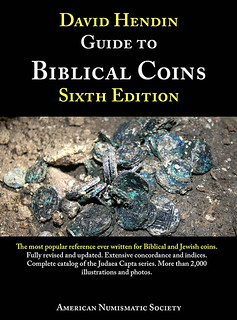 Many people are interested in ancient coins, but not too many stay with it for over half a century! After nearly 50 years of writing and revising, and on the eve of publication of my book Guide to Biblical Coins 6th Edition, I can assure readers that the process of creation and revision of a book like this is not a straightforward process. This is true even though texts on the topic have existed for nearly 200 years.
Many people are interested in ancient coins, but not too many stay with it for over half a century! After nearly 50 years of writing and revising, and on the eve of publication of my book Guide to Biblical Coins 6th Edition, I can assure readers that the process of creation and revision of a book like this is not a straightforward process. This is true even though texts on the topic have existed for nearly 200 years.
Take for example the problem of dating coins; despite the fact that some coins actually come with dates, it is not always clear what those dates refer to. For example, in his 1881 Coins of the Jews, numismatist Frederick Madden attributed the silver coins inscribed shekel of Israel,
half a shekel,
and the bronze shekel fractions dated year four to Simon Thassi (died 135 BCE) of the Hasmonean dynasty. Madden also attributed coins with the names Eleazar and Simon to the first year of the Jewish War against Rome (66-70 CE). Today Eleazar and Simon are known to be Bar Kokhba coins, issued by the Judean state during its final revolt against Rome from 132-135 CE.
The issue of dating gets predictably more difficult with earlier coinage. My friend and teacher, the late Ya'akov Meshorer (Chief Curator of Archaeology at the Israel Museum) correctly dated all of the Jewish War and Bar Kokhba Revolt coins in his 1967 Jewish Coins of the Second Temple Period. But Meshorer shook up the establishment by theorizing that Alexander Jannaeus (who reigned from 104-76 BCE) struck the first Hasmonean coins.
He further posited that Jannaeus issues were followed by coins struck by subsequent Hasmonean kings, Hyrcanus II, Aristobulus II, and Mattatayah Antigonus (the last king of the dynasty, executed by the Romans in 37 BCE after being captured and handed over by Herod, who had already been proclaimed King
by the Romans).
But Meshorer's theory was quickly countered by Arie Kindler (of the Haaretz Museum and Tel Aviv University) who wrote in Coins of the Land of Israel in 1974 that the Hasmoneans struck coins in this order: Hyrcanus I, Aristobulus I, Jannaeus, Hyrcanus II, and Mattathias Antigonus. The problem is that coins with the name Yehochanan (or John) could refer to Hyrcanus I (135-104 BCE) or to his grandson Hyrcanus II who reigned some 40 years later. This meant uncertainty regarding sites or strata dated by such coins.
In 1976 this writer entered the fray with the first edition of Guide to Ancient Jewish Coins. Like Kindler, I also highlighted the find of a coin struck by the Syrian king Antiochus VII in Jerusalem bearing both a date and a Judean symbol as a chronological anchor. But I still followed Meshorer's then current theory of Hasmonean coin chronology (only until my 3rd edition).
The revisions continue. Guide to Ancient Jewish Coins was retitled Guide to Biblical Coins for subsequent editions 2nd (1987), 3rd (1996), 4th (2001), and 5th (2010). This fall the 6th edition will be published by the American Numismatic Society (ANS). I am happy to have gifted all rights and revenues for this book to the ANS.
Over the decades I have updated my book to include the most recent research, including from over 75 papers I have written or co-written with colleagues. My archaeological fieldwork at Sepphoris with Duke University and Hebrew University dramatically enhanced knowledge, as have my site visits to hundreds of locations in Israel, the Palestinian Territories, Jordan, Egypt, and Lebanon with friends and colleagues.
In addition to adding new types, removing incorrectly attributed coins, and refining chronology (seriation) of the coins, I have also added new topics of interest. For example, in the 4th edition I added a section covering and listing coins countermarked by the Roman legions stationed in the ancient Holy Land. In the 5th edition I added text and an extensive catalog of the Judaea Capta coins, issued by the Emperor Vespasian to celebrate his son Titus' destruction of the Second Temple in 70 CE.
Numismatics is an important ancillary field to archaeology, anthropology, history, mathematics, and economics. Yet few universities worldwide offer numismatic tracks. Top academic numismatists may be professors, but they are often diplomats, attorneys, doctors, businessmen, writers, clergymen, or even coin dealers. As noted by Frank L. Holt in his engaging When Money Talks: A History of Coins and Numismatics, the scholarly societies that publish the journals still welcome collectors and dealers as members and officers. Their research journals still accept papers written by well-informed non-academics, and their own cabinets still rely heavily on bequests from generous collectors and dealers.
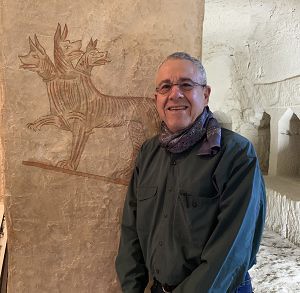 I take my work as a numismatic historian and guardian of an archive information seriously, and do my best to bring a two-thousand-year tradition of collecting and studying Judean coins up to date with current ideas as well as stories about some of the key players over the past 50 years. The newest edition has more reference citations, more endnotes and comments, many more photos and illustrations, and better indices and a concordance. But in addition to numismatics and archaeology, my career has been as a journalist, publisher, and literary agent. In the latest edition I talk about my friendship with Charles M. Schulz, creator of PEANUTS and how his interest in my numismatic and archaeology work in Israel turned into an adventure for Snoopy's twin brother Spike.
I take my work as a numismatic historian and guardian of an archive information seriously, and do my best to bring a two-thousand-year tradition of collecting and studying Judean coins up to date with current ideas as well as stories about some of the key players over the past 50 years. The newest edition has more reference citations, more endnotes and comments, many more photos and illustrations, and better indices and a concordance. But in addition to numismatics and archaeology, my career has been as a journalist, publisher, and literary agent. In the latest edition I talk about my friendship with Charles M. Schulz, creator of PEANUTS and how his interest in my numismatic and archaeology work in Israel turned into an adventure for Snoopy's twin brother Spike.
The goal of Guide to Biblical Coins has been to inform scholars and collectors who seek an overview of the coins of the Second Temple Period, which also played a critical role in the formation and evolution of Christianity. This work will continue.
To read the complete article, see:
A Half a Century of Studying Biblical Coins
(https://www.asor.org/anetoday/2021/11/studying-biblical-coins)

NEW BOOK: CATALOG OF BELGIAN NUMISMATICS 2022
Laurens Aernout has published a new edition of his catalog of Belgian numismatics. -Editor
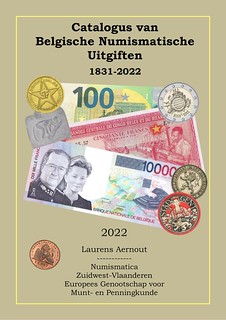 This is the most complete catalogue of Belgium and Belgian congo. Used by every Belgian collector.
This is the most complete catalogue of Belgium and Belgian congo. Used by every Belgian collector.
Contents: the coins, notes and sets of the Belgian franc as well as the euro. This also includes the Belgian ECU coins, tokens and sets, together with the commemorative medals, the local issues and notes of the Belgian army, the coins and notes of the Congo Free State, the Belgian Congo and the mandate areas. Also the tax plates of the Belgian Congo!
All this with updated prices and with new variants, in words and pictures!
Main language Dutch with French and English Lexicon.
Features: 800 pages (!), black/white, 17cm high x 12cm wide x 3,5cm thick, 850gr +, ISBN 9789082449037
Price: 20EUR
The catalog is available via ebay, the post, at your local coin club, at the standard bookstores, at your local coin shop, etc.!
For more information, or to order, see:
http://www.cbnu.be/home/
NEW PERIODICAL: HALF CRAZY
Seated Half Society President Dennis Fortier and Vice-President Verne Pitman announced a new club for collectors of Liberty Seated Half Dollars. The official publication of Seated Half Society is called Half Crazy and will be published quarterly as part of E-Gobrecht, the newsletter of the Liberty Seated Collectors Club (LSCC). -Editor
Half Crazy - The Newsletter of the Seated Half Society - Issue #1
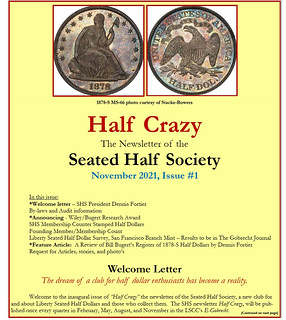 The SHS is an association of dedicated Liberty Seated Half Dollar devotees and specialists. My experience at club tables around the country over the last thirteen years has taught me that of all the Liberty Seated denominations, half dollars are the most widely collected within the Liberty Seated series.
The SHS is an association of dedicated Liberty Seated Half Dollar devotees and specialists. My experience at club tables around the country over the last thirteen years has taught me that of all the Liberty Seated denominations, half dollars are the most widely collected within the Liberty Seated series.
The SHS is built a bit differently than traditional clubs. Thanks to the LSCC leadership, the need for the infrastructure associated with most clubs is not required here. The LSCC has generously loaned space on their website and in this publication for the needs of the SHS. As such no dues will be required, and volunteer leadership will be at a minimum. Verne Pitman has volunteered to serve as our first Vice-President, and myself, Dennis
Fortier will serve as President In addition to membership in the LSCC, a significant collection of Liberty Seated Half Dollars is required for membership in the SHS. To be a bit more clear; high grade collections are not a narrow requirement for membership. What is required is a demonstrated passion for the series at whatever level your pocket book allows. A 100 point system has been established to hopefully encompass many of the ways Liberty Seated Half Dollars are collected. Please see the club webpage for more details on the point system for membership.
Unlike the LSCC, which is open to everyone, membership in the SHS must be earned through building a significant collection of Liberty Seated Half Dollars. In years to come, it is hoped membership in the SHS will be looked upon as a numismatic accomplishment in the career of a Liberty Seated Half Dollar collector.
If you believe you qualify for membership, please contact Verne Pitman or myself to schedule an audit of your collection. All who qualify are welcome. We hope you will join our association and become a founding member of the Seated Half Society.
For more information, see:
http://www.lsccweb.org/SHS-homepage.shtml
ANA LIBRARY REOPENS FOR IN-PERSON SERVICES
At long last, the ANA Library is reopening for in-person services. Here's the announcement. -Editor
American Numismatic Association Reopens Library for In-Person Services
The American Numismatic Association's Dwight N. Manley Numismatic Library is again welcoming members to utilize its collection and services. The library is now open to in-person guests again after being closed for two years due to the COVID-19 pandemic. The library will be open during museum hours, Tuesday through Friday, 10:30 a.m. to 5 p.m.
The public is welcome to browse and read our holdings, and ANA members can check out books to read at their leisure. The library also offers research services for those with a particular topic of interest in numismatics or other related areas.
ANA members can access the world's largest numismatic lending library and borrow its more than 128,000 books, auction catalogs, periodicals and DVDs online (for the price of postage). The library features resources and materials on subjects including but not limited to coins, paper money, tokens, medals, military orders and decorations, and stocks and bonds.
Please visit our website at money.org or call (800) 367-9723 for more information.
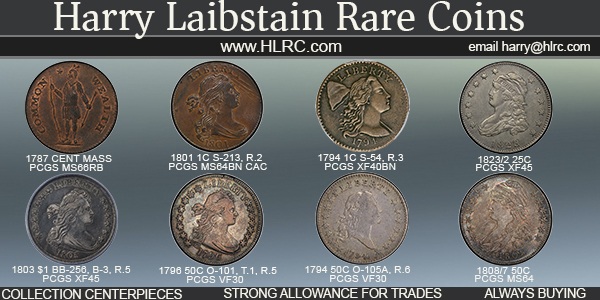
A THANKSGIVING THAT WASN'T
Newman Numismatic Portal Project Coordinator Len Augsburger submitted this holiday item. Thanks. Amazing medal! -Editor
A Thanksgiving That Wasn't
When is Thanksgiving not Thanksgiving? An 1872 UK National Thanksgiving
medal by Wyon actually commemorated a March 1872 service in St. Paul's Cathedral, attended by Queen Victoria, that celebrated the recovery of the Prince of Wales from typhoid. This piece from the Goldberg's January 2014 sale, lot 3238, is described as Great Britain Medal, 1872 BHM-2928; Eimer-1618. Bronze. 77 mm. By J.S. & A.B. Wyon. Victoria. Prince of Wales, National Thanksgiving. Londonia inviting Queen Victoria and the Prince of Wales to enter St. Paul's Cathedral, Britannia standing nght. Reverse. A view of the interior of St. Paul's with congregation, royal arms to left and those of the City of London to right.
The medal realized $588 on a $200 to $250 estimate.
Link to Goldberg auction sale catalogs on Newman Portal:
https://nnp.wustl.edu/library/auctioncompanydetail/7

VIDEO: RANDY'L TETON MODELS SACAGAWEA
These are selections from the David Lisot Video Library that feature news and personalities from the world of coin collecting. David has been attending coin conventions since 1972 and began videotaping in 1985. The Newman Numismatic Portal now lists all David's videos on their website at:
https://nnp.wustl.edu/library/multimediadetail/522852
Here's a 2001 interview with Sacagawea dollar model Randy'L Teton. -Editor
VIDEO OF THE WEEK: August 8, 2001
Videotaped at the ANA World's Fair of Money
Sacagawea, Face of the New Millennium
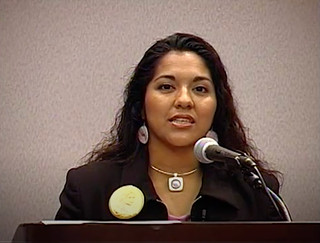 Join Randy'L Teton, ANA intern, art historian and the model for Sacagawea on the new golden dollar, as she shares her personal experiences of the coin's development. Ms. Teton gives a fascinating intimate history of the young Shasone Indian girl, Sacagawea, from her capture by an hostile Indian tribe to her travels with Lewis and Clark as well as the mystery of her later days. This video includes:
Join Randy'L Teton, ANA intern, art historian and the model for Sacagawea on the new golden dollar, as she shares her personal experiences of the coin's development. Ms. Teton gives a fascinating intimate history of the young Shasone Indian girl, Sacagawea, from her capture by an hostile Indian tribe to her travels with Lewis and Clark as well as the mystery of her later days. This video includes:
How to CORRECTLY pronounce "Sacagawea" - Sacagawea's story as told through the oral tradition within the Shasone Tribe - The challenges in getting the stories from the Elders of the tribe - Sacagawea's baby as shown on the coin and how she traveled with him - The adventures of Sacagawea's son, Jean-Baptist - How Randy became involved with the program - Her decision to go public as a Native American personality - The stress of public notoriety - How the decision process for the coin design took place - How the proposed images were voted on over the Internet - How Native American Indians have been misrepresented in history - Recommend books to read for young and old
Speaker(s): Randy'L H. Teton.
Length: 48:17
The video is available for viewing on NNP at:
https://nnp.wustl.edu/library/book/557043

NOTES FROM E-SYLUM READERS: NOVEMBER 21, 2021
Stolen 1652 Commonwealth Unite
"BOLO (be on the lookout) for the following rare British gold coin--the package was slit open and the coin removed and the package was resealed with clear tape:
Great Britain 1652 Commonwealth Unite--PCGS AU55 (pcgs certificate number: 144322.55/05250592)
Shipment was mailed in San Diego, CA --on Nov 9th---registered mail to Cary, NC----please save the attached photos of the coin in the pcgs slab---if you are offered this coin---please contact us ASAP---our tel # 802-369-6518 or email us."
Bob's email address is: robertstein590@comcast.net . -Editor
Story Vaults
Regarding Global Certification Services,
Jeff Garrett of Mid-American Rare Coin Galleries, Inc writes:
"I was partners with Bob Paul from the Philadelphia area with Global certification about 10-15 years ago. We developed the product to market coins and tell the stories of each issue. Bob Paul still operates Global on a limited basis.
We decided that most of our customers prefer certified coins and we later developed the attached product. The Story Vaults hold an NGC coin, with an image and the story on the back. These have been a very popular and successful way to market ancient coins. A lot of companies sell these at shows and on the internet."
Thanks. Jeff provided these images of the evolved product. See my Numismatic Diary article in this issue for another example of a Global Certification Services slab I found at the Baltimore show this week. -Editor
To read the earlier E-Sylum article, see:
QUERY: GLOBAL CERTIFICATION SERVICES
(https://www.coinbooks.org/v24/esylum_v24n46a13.html)
Best Cartoon Series
Regarding Parnell Nelson's cartoons in The Celator,
Mike Marotta writes:
"Back in the 20th century, I attended a Numismatic Literary Guild dinner bash parody party at the invitation of a publisher. The open bar should have been the first clue but I was not prepared for the experience. Anyway, at that event, Parnell Nelson's publisher, The Celator, was granted an award (as close as I can recall) for "Best Cartoon Series Appearing in a Monthly Periodical Dedicated to World or Ancient Numismatics."
It seemed to me that the nods were all invented to make sure that everyone got something with equivalent honors for news, features, and editorials going to Numismatic News and Coin World and to Coins and CoinAge and so on. I believe that the signed certificate for Parnell Nelson of The Celator was to make up for the fact that the laurels for Best Monthly Periodical Not About US Coins went to Krause's World Coin News, but I could be wrong about that. The NLG website does not provide a roster of previous awards and awardees."
To read the earlier E-Sylum article, see:
NOTES FROM E-SYLUM READERS: NOVEMBER 14, 2021 : Parnell Nelson Ancient Coins Cartoons
(https://www.coinbooks.org/v24/esylum_v24n46a12.html)
Baltimore Liberty Seated Collectors Club Presentations
I wasn't at this week's Baltimore show the day of the Liberty Seated Collectors Club (LSCC) meeting, but Paul Kluth forwarded these photos of Len Augsburger and Dennis Fortier giving presentations. Thanks. -Editor
For more information on the Liberty Seated Collectors Club, see:
http://www.lsccweb.org/
Honoring The Creators of Superman
"If you missed the induction of Jerry Siegel and Joe Shuster, the creators of Superman, into the Jewish-American Hall of Fame, you can watch the 2-hour program on Facebook or on YouTube. Participants include Eugene Daub, who created the Siegel & Shuster medal and plaque, Sam Asher, who shows the JAHF plaques on display at the Virginia Holocaust Museum, Abby Schwartz, who is Executive Director of the Skirball Museum in Cincinnati, the home of the Jewish-American Hall of Fame Medal Collection, Mel Wacks, Founding Director of the JAHF, and others. For medal availability and prices contact directorjahf@yahoo.com.
To watch the event, see:
It's A bird, It's A Plane: Honoring The Creators of Superman
(https://www.facebook.com/watch/live/?ref=watch_permalink&v=577827363450254)
It's A bird, It's A Plane: Honoring The Creators of Superman
(https://www.youtube.com/watch?v=FyOmqiQM0dY)

NICKLE GALLERIES CREATES 3D COIN IMAGES
Arthur Shippee forwarded this article on studying ancient coins in 3D at Calgary's Nickle Galleries. Found via The Explorator newsletter. To subscribe to Explorator, send a blank email message to: explorator+subscribe@groups.io. -Editor
Cryptocurrencies are attracting a lot of attention these days, but Scott Coleman prefers to focus on money — the physical kind — from the distant past. Graduating with a master's degree in Greek and Roman Studies, he has a fascination with coins from the Roman and Byzantine Empires.
Numismatics can provide a link between the modern world and the past,
explains Coleman. Money, specifically coins, are tangible and tactile material culture that all humankind can relate to and share as a common cultural heritage.
After completing his BA in history at Memorial University, Coleman moved west to study with Dr. Marica Cassis, PhD, associate professor and head of the Department of Classics and Religion. He soon discovered the treasure trove awaiting him at the University of Calgary, housed in Nickle Galleries: the Nickle Numismatic Collection, one of the most historically significant collections of coins and paper money in Canada. It includes 150 gold and bronze coins that circulated more than 1,000 years ago across the Byzantine Empire's territories which included the Balkans, Asia Minor, parts of the Middle East and North Africa.
In the summer of 2020, Coleman was scheduled to conduct field work in Greece, but the COVID-19 pandemic postponed his travel plans. That twist of fate affected his work in an intriguing, positive way. The lockdown forced him to think about how to broaden access to museum artifacts and changed the course of his research.
With museums and galleries closed, it meant many artifacts were inaccessible to the public,
he explains. I started looking at how museums represent coins and I focused within Greece, given that was the region I was preparing to study for my practicum.
Throughout his research, Coleman delved deep into the Nickle Numismatic Collection, working closely with collections specialist Marina Fischer. Inspired by the use of 3D technology for mapping ancient sites, Coleman realized that creating digital images of the coins would make them more accessible for researchers and the public. He began collaborating with technology specialist Jed Baker in Libraries and Cultural Resources, experimenting with photogrammetry to create 3D images of rare coins.
If you digitize them and create these 3D images, then everyone has access to these coins by exploring them online. They don't have to be in a museum display in a 2D format where you only see one side of them. It's a great way to start presenting coins to everybody, and it's a great way for people to interact with coins.
A continuation of this work could include augmented reality, in which a 3D image is manipulated to more easily study the detailed markings and stunning artwork found on many rare coins. Coleman points to an example of this approach that resulted from a project at the Sarajevo Museum.
To read the complete article, see:
When historical artifacts and modern technology collide
(https://ucalgary.ca/news/when-historical-artifacts-and-modern-technology-collide)
X-RAY SPECTROSCOPY ROMAN COINS STUDY
Researchers from the University of Oxford and the University of Warwick studied three Roman coins with advanced non-destructive techniques. -Editor
 A study of gold coins from different moments of the Roman Empire has revealed the thriving economy at the time of minting.
A study of gold coins from different moments of the Roman Empire has revealed the thriving economy at the time of minting.
To reach this conclusion, researchers brought three Roman coins to the Science and Technology Facilities Council's ISIS Neutron and Muon Source for analysis.
When high-value artifacts need to be analyzed researchers are generally required to employ non-destructive techniques.
Researchers from the University of Oxford and the University of Warwick brought three Roman coins to the ISIS facility. The team wanted to see if the coins had been surface enriched, or secretly mixed with other metals.
By doing this, the researchers could deduce a number of things about the society they came from, including the level of economic stability.
The coins analyzed were issued during the reigns of three different Roman emperors:
- Tiberius (early 1st century AD)
- Hadrian (mid-2nd century AD)
- Julian II (mid-4th century AD).
To measure the purity of the gold coins they used muonic X-ray emission spectroscopy, a totally non-destructive analytical process that involves firing negative muons at the artifact.
The muons are then captured by the atoms within the coins, which then emit a 'fingerprint' of muonic X-rays that are unique to the chemical element they came from.
Lead author Dr. George Green of the University of Oxford said: "The results from the surface level analyzes of these coins suggested that they were very high purity gold. However, these measurements were from the first few fractions of millimeters of the coins, so there was a very reasonable 'what if.' What if they're actually made of something different beneath the surface? We know that the Romans deliberately surface enriched their silver coins to 'hide' the fact there was a lot of copper in them, so it is plausible something similar happened to the gold. Our work at ISIS enabled us to sample the very center of these coins totally non-destructively and conclusively show that the high purity seen on the surface was representative of the composition of the 'core' of the coin. At a basic level it is further testament to the economic health of the Roman Empire, but these conclusions are also useful for researchers who need to employ non or negligibly-destructive techniques on the surfaces of Roman gold coins. Now they can be confident the surface is representative of the bulk of these objects."
To read the complete article, see:
Muonic X-ray emission spectroscopy study of Roman coins reveals thriving empires
(https://phys.org/news/2021-11-muonic-x-ray-emission-spectroscopy-roman.html)
PHYSICIST WORKS TO FOIL COUNTERFEITERS
This article discusses work by physicists at Notre Dame to unearth currency fraud and forgery throughout history. -Editor
Most people associate nuclear physics with the atomic bomb or nuclear power plants, and those associations are often negative. Michael Wiescher, a nuclear physicist at the University of Notre Dame, wants to change that perception by applying his expertise—and some of his sophisticated imaging hardware—to research that bridges science, history, and culture. His work in this area has included collaborations to analyze a rare medieval manuscript and unearth currency fraud and forgery throughout history, most notably in ancient Rome and Colonial America. He recently described those efforts at a virtual meeting of the American Physical Society's Division of Nuclear Physics.
Much of this work was conducted in conjunction with undergraduate students in physics, chemistry, art restoration, history, and anthropology as part of a course Wiescher teaches at Notre Dame on physics-based methods and techniques in art and archaeology. In the process, students can get certified as operators of a broad range of advanced physics-based instruments and techniques. These include Raman spectrometers, transmission electron microscopes (TEM), a 3MV tandem accelerator, handheld X-ray fluorescence (XRF) scanners, micro-XRF scanners, and X-ray diffractometers, among others.
Wiescher turned his attention to Roman denarii in 2019. The Roman silver denarius was the backbone currency of the Roman Empire between 200 BCE and 300 CE, according to Wiescher. During Nero's reign, the coins were required to be 92.5 percent silver, in order to protect the currency against inflation and devaluation. Despite the emperor's reputation for tyranny and debauchery, "Nero was one of the most fiscally responsible of his progenitors and successors, sticking to the laws in the way of having the coins minted," said Wiescher.
But the analysis of coins from 250 to 350 CE showed declining percentages of silver. According to Wiescher, the Roman mints gradually debased the denarius, deliberately, to increase their profits and make it easier to finance ongoing wars in the empire. The mints relied on certain metallurgical techniques to hide the lower percentages of silver to keep inflation at bay. By 295 CE, the silver content was just about 5 percent.
Wiescher and his students combined XRF scaling with PIXE mapping of the coins to test the currency's quality and learn more about the production techniques. They also used electron spectroscopy to measure the silver content of each coin and how the impurities were distributed. Their analysis revealed that most of the coins are composed of silver and copper and that sulfur and iron impurities led to corrosion in some of them.
Merchants would typically test any coins proffered as payment by biting on them, since they should be able to taste the silver. This would reveal any attempt to cut corners. "So the Romans invented a number of interesting technologies in metallurgy to hide [that debasement]," said Wiescher. For instance, throwing a mixed silver/copper coin into liquid mercury will cause the silver to dissolve and flow around the coin. "Then you remove the coin from the mercury bath and heat it up to drive the mercury out," said Wiescher. This gives you a silver coin with a copper core, capable of passing the bite test.
The same trick of replacing some of the silver in coins with copper showed up again thousands of years later in Spain's Latin American colonies. Wiescher analyzed 91 silver rials dated between the 16th and 18th centuries, from Mexico and Potosi, Bolivia. Between 1645-1648, the silver content dropped from 92.5 percent sterling to just 70-80 percent; the rest was a copper admixture. When this was discovered in the 17th century, the silver market in Spain crashed and the coins were devalued, with devastating effects on the colonial Spanish economy, per Wiescher.
Some of that silver from Spain and Mexico eventually made its way to the early American colonies. The colonies initially adopted the bartering system of the Native Americans, trading furs and strings of decorative shells known as wampum, as well as crops and imported manufactured items like nails. But the Boston Mint used Spanish silver between 1653 and 1686 for minting coins, once again adding a little copper or iron to increase their profits.
The article also discusses using the techniques to study Benjamin Franklin's anti-counterfeiting techniques in printing Colonial currency. -Editor
To read the complete article, see:
A physicist studied Ben Franklin's clever tricks to foil currency counterfeiters
(https://arstechnica.com/science/2021/11/history-detective-using-physics-to-track-currency-fraud-forgery-through-history/)

PRINCETON SEEKS BYZANTINE CATALOGUER
The Numismatic Collection of Firestone Library Collections, Princeton University is seeking candidates for a Byzantine Numismatic Cataloguer position. Applications may be submitted at least through December 15, 2021. -Editor
 The Numismatic Collection of Firestone Library Collections, Princeton University, seeks a specialist to provide detailed description of over five thousand coins of the Byzantine Empire from the newly acquired Donald and Theodotou Collections. The work includes examination of coins, comparison with published descriptions, data entry in a specialized database, and digital photography. Sorting coins into trays and labelling them are included. If time permits, additional related duties may be assigned, including limited supervision of student cataloguers. The position reports to the Curator of Numismatics. The person hired will also be involved in the establishment of a federated database to catalogue and digitize Byzantine coin holdings in various collections worldwide. The position is for one year, with the possibility of renewal for a second-year dependent on availability and performance of position holder and availability of funds
The Numismatic Collection of Firestone Library Collections, Princeton University, seeks a specialist to provide detailed description of over five thousand coins of the Byzantine Empire from the newly acquired Donald and Theodotou Collections. The work includes examination of coins, comparison with published descriptions, data entry in a specialized database, and digital photography. Sorting coins into trays and labelling them are included. If time permits, additional related duties may be assigned, including limited supervision of student cataloguers. The position reports to the Curator of Numismatics. The person hired will also be involved in the establishment of a federated database to catalogue and digitize Byzantine coin holdings in various collections worldwide. The position is for one year, with the possibility of renewal for a second-year dependent on availability and performance of position holder and availability of funds
Major Responsibilities
- Catalogue the newly acquired Peter J. Donald and Chris Theodotou collections of Byzantine Coins into the Library's online digital database
- Catalogue other uncatalogued Byzantine coins of the Firestone Library's numismatic collection, the Princeton University Art Museum, and the Antioch Excavation Collection into the Library's online database and integrate all coins on trays with proper identifying labels
- Work with representatives of the Dumbarton Oaks Research Center and nomisma.org to establish and implement a linked-open data platform for Byzantine coins
- Research and establish unique issue identifiers for Byzantine coins for the period 1204-1453.
Dr. Alan Stahl (Curator of Numismatics) and Donald Thornbury (Head, Technical Services for Special Collections) will mentor and supervise the cataloguer in their daily work, and will hold a joint bi-weekly meeting in which he or she will report on their advancement.
Essential Qualifications
- Advanced degree in History, Classics, Art History or related field, with significant work on Byzantium or the medieval Mediterranean.
- Demonstrated ability to work efficiently and productively with scholarly resources and to meet production goals.
- Ability to work both independently and collaboratively with curatorial and technical staff.
- Must comply with RBSC security procedures.
Preferred Qualifications
- Experience with numismatic description.
- Experience with management of structured descriptive data for library resources and for digital databases
- Experience with digital photography and Adobe PhotoShop.
To read the complete position description, see:
Application for Byzantine Numismatic Cataloguer and Linked-Open-Data Coordinator
(https://puwebp.princeton.edu/AcadHire/apply/application.xhtml?listingId=23342)
VOCABULARY TERM: GALVANO MEDAL
Here's another entry from Dick Johnson's Encyclopedia of Coin and Medal Terminology. -Editor
Galvano Medal. A medallic item made of one or two galvanos; an electrotype. Galvano medals are all medallic items made by electrodeposition of one or two sides and smaller than eight inches (or 20 centimeters). Larger such items are galvano plaques (almost always one sided). No die is required for these objects as they are not struck. Instead they are formed from a pattern by electrogalvanic casting, and noted for their very high fidelity to that pattern. Thus galvano patterns are highly detailed, galvano medals are likewise.
Galvanos are formed in tanks and the limit to their size is bound only by the size of the tank (mostly up to 60 inches). Thus medals, medalets, medallions, plaques, plaquettes (and tablets) can be easily made as galvanos, and all of these – except galvano plaques and tablets – are known as galvano medals.
The advantage of galvano medals versus struck medals is their high fidelity, plus the fact they are ideal for short runs. If say less than 50 items are required – ever! – it is cheaper and quicker to make them by galvano casting than by creating a die or dies and striking. If more than 50 are required it is better to have dies made that can be struck at any time. Dies or galvano patterns are made from artist's models and can be stored for future use.
History. Galvano is named after an Italian, Luigi (or Alolsio) Galvani, who, in 1791, first observed electric current. Michael Faraday, an Englishman, developed the generation of direct current in the 1830s. But it was a German, Moritz Herman von Jacobi (1801-1874), who developed, in 1837, the process using electric current he called "galvanoplasty" which today is known as electroforming.
The British immediately embraced this process to create electroplating, obtaining the first patents in 1840. The British also used this process to replicate, or duplicate, existing small bas-relief objects. The British Museum, in 1859, appointed a sealmaker, Robert Cooper Ready (1811-1901), to electroform objects – including coins and medals – in the Museum's collections. (In his lifetime Ready made over 22,000 of these, and his son, Augustus P. Ready carried on after him.) See electrotype.
Galvano medal characteristics. Each side of a galvano medal is made separately. A one-sided galvano casting is usually backed with metal to give it additional strength, as it can be made extremely thin. A two-sided galvano medal is made by attaching a flat back or a second galvano to form the reverse with design.
Two-sided galvanos are joined together with a drop-in, a molten medal – as lead, solder or pot metal – is applied to fill the inside cavity and to make it a somewhat "solid" medal. With two sides joined together, there is, of course, a seam around the edge.
Fortunately galvanos can be made in typical coin and medal compositions – copper, silver, gold – and can be made to resemble a numismatic item in these compositions (called electrotypes by numismatists). Any pure metal that conducts electricity can be electroformed (including nickel, chromium, palladium, others, or, these can also be employed to electroplate any hard surface).
Galvanos can be finished or left uncolored. They can be highlighted or given a patina finish. Copper galvanos can be easily finished to replicate any bronze color. Untreated copper galvanos will turn brown from their original copper red just like an untreated coin. They can be lacquered to retain their original patina color or left unlacquered to tone or darken naturally.
Galvano medal diagnostics. Thus the diagnostic evidence to identify galvano medals are: (1) a seam around the edge if two-sided, (2) a composition of pure metal element (usually copper), (3) possible additional metal added to the back or inside for strength, (4) a lighter weight and different specific gravity than a solid medal of similar diameter. All other evidence would indicate a struck piece as well as an electroformed medal.
Cataloging galvano medals. In numismatic cataloging, galvano medals should be identified as what they are. Their composition is not obvious from inspection but the color should be mentioned (copper red or brown, silver gray, gold yellow); it is not necessary to identify the composition of the drop-in but this should be mentioned if it is present (and not covered by a backplate). Galvanos can be given a patina finish and this, too, should be mentioned in cataloging.
For additional information, particularly on the fidelity of a galvano casting to its pattern, see electrotype, electroforming and electroplating.
References:
O6 {1911} ANS, p 26-33, 263-266.
To read the complete entry on the Newman Numismatic Portal, see:
Galvano Medal
(https://nnp.wustl.edu/library/dictionarydetail/515978)
ROBERT ARTHUR JOSLIN, SR. (1935-2005)
American Numismatic Biographies author Pete Smith submitted this article on advertising mirrors and coin dealer Robert Arthur Joslin, Sr. Thanks! -Editor
Each week I try to submit a brief article on some historical figure in numismatics. My subject this week may be important to no one but myself. He solved a mystery for me.
The story begins with (1) an advertising mirror from Eagle Coin Co. in Owatonna, MN. In January 2017, I acquired (2) another Eagle Coin Co. mirror from Fort Dodge, Iowa. I submitted an item for The E-Sylum asking for a connection between the two mirrors. No answer was provided. Then this past week I acquired (3) another Eagle Coin Co. mirror from Fort Dodge. A search on the internet turned up (4) another Eagle Coin Co mirror from Fort Dodge that I don't have. I believe all of them were produced for Robert A. Joslin.
Joslin was born on June 18, 1935, in Tara, Iowa. His parents were Earl Jasper Joslin (1917-1999) and Ruth Beatrice Burkholder Joslin (1919-2015). Robert married Faye Arloine Hanson in 1958. They had three sons and two daughters. Faye was living as recently as 2019.
In 1974 he joined the ANA as member R-78701 with an address in Clarion, Iowa. There he was an active member of the Clarion Coin club serving as club secretary in 1964, chairman of the coin show in 1969, president in 1971, and as auctioneer in 1974. Clarion had a population around 3000 in 1970 and reported attendance around 35 members at each meeting.
It is less than 40 miles from Clarion to Fort Dodge, Iowa. Joslin had a P. O. Box there in 1976. By 1978 he had a coin shop in the Cedar Mall in Owatonna.
In 1983 he joined the Central States Numismatic Society as member 4136 with an address in Owatonna, Minnesota.
Robert and Faye had retired to Pima, Arizona. Robert died on July 13, 2005, at Homestead Hospice in Owatonna. He is buried at Saint Olaf Lutheran Cemetery in Bode, Iowa, the hometown of his wife. His obituary said nothing about his profession.
I sent an inquiry to the Owatonna Public Library asking about the Eagle Coin Co. and the name of the proprietor. Once I had the name, it was easy to find an obituary for Joslin. The Fort Dodge mirrors were likely produced around 1976-77 and the Owatonna mirrors around 1978-79.
Shards of pottery found by an archaeologist will represent the material culture of a native tribe. Advertising mirrors may represent the material culture for a coin dealer who would otherwise be forgotten.
I have determined that I am the only person in the world interested in coin dealer advertising mirrors. I would be very interested to learn of other advertising mirrors issued by coin dealers.
If there are more numismatic advertising mirror collectors out there, we've love to hear from you! -Editor
To read earlier E-Sylum articles, see:
NEWMAN PORTAL ADDS NUMISMATIC MIRRORS BOOK
(https://www.coinbooks.org/v20/esylum_v20n02a09.html)
NOTES FROM E-SYLUM READERS: JANUARY 8, 2017 : Query: Eagle Coin Co.
(https://www.coinbooks.org/v20/esylum_v20n02a14.html)
HARVEY STACK'S NUMISMATIC FAMILY, PART 109
The latest article in Harvey Stack's blog series is on the auctions of 1990. Thanks. -Editor
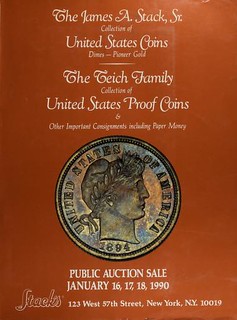 As noted earlier, in 1990 Stack's presented 11 separate catalogs for their auction season, again offering a wide range of numismatic items to meet the needs of all kinds of collectors. January started off with items from the James A. Stack, Sr. Collection, including an extensive and virtually complete set of United States dimes from 1796 to date, mostly in Proof and Mint State. Also included were Proof coins of the United States from 1858 through 1915, nearly complete from the cent to silver dollar. Among the 1,827 lots was the very rare 1894-S dime.
As noted earlier, in 1990 Stack's presented 11 separate catalogs for their auction season, again offering a wide range of numismatic items to meet the needs of all kinds of collectors. January started off with items from the James A. Stack, Sr. Collection, including an extensive and virtually complete set of United States dimes from 1796 to date, mostly in Proof and Mint State. Also included were Proof coins of the United States from 1858 through 1915, nearly complete from the cent to silver dollar. Among the 1,827 lots was the very rare 1894-S dime.
March brought two separate catalogs focused on different specialties. First was our offering of over 1,500 lots of United States gold and silver from a Prominent Numismatist, in this case someone who wished to remain anonymous. It was a wonderful array of popular and high-quality items, a sale that had something for everyone.
Our presentation of material from the James A. Stack, Jr. Collection continued on March 15 with a specialized collection of over 420 lots of choice and rare United States Paper Money. It was basically a type set and included Demand Notes, Legal Tender Notes, Compound Interest Notes, Gold Certificates, Treasury Notes, Federal Reserve Notes, and Silver Certificates, as well as Gold Bank and National Bank Notes. Most were Crisp Uncirculated and the sale attracted many collectors of these popular series.
In May 1990 we once again held an auction in conjunction with the Metropolitan New York Numismatic Convention, held at the Park Sheraton Hotel in New York. This major show drew audiences from across the country and our sale was a comprehensive offering of nearly 2,200 lots of rare United States gold, silver, and copper coins, from a number of different consignors. The following month we presented the Adrian Ross Collection of United States Copper Coins, some 1,846 lots of United States and colonial issues that included many rarities. The half cent collection was virtually complete, the large cents included numerous varieties, and the small cents brought to market many Proof and Mint State examples. Many of the coins in the collection had been originally acquired from Stack's over a period of 50 years, both through over the counter sales as well as auction lots.
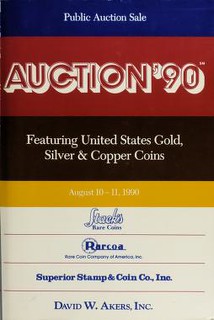 Our annual
Our annual Apostrophe
event with partners Rarcoa, Superior, and David Akers was once again a highlight of the summer auction season when it crossed the block in August. Each company offered their own selection of rare and choice United States coins and the quality of the material attracted collectors from all over of the country. As always, it was a highlight event for vacationing and traveling numismatists.
September brought a super array of early United States silver coins, plus a large collection of United States gold and territorial pieces. These were consigned by a major financial institution and the sale totaled over 1,550 choice and rare lots. For generations Stack's had been fortunate to be selected by a record number of bank and trust companies and well-known financial institutions when they needed assistance with numismatic related sales.
 In honor of Stack's 55th anniversary as public auctioneers in October (another record in the field), we were fortunate to present the famous Allen F. Lovejoy Collection of United States Dimes, 1796 to date. This cabinet featured one of the most extensive groups of dime die varieties and outstanding grades ever auctioned. It contained nearly 650 lots and had been formed over several decades, with Mr. Lovejoy working closely with both Harvey and Norman Stack. Such an important sale drew personal attendance from dime collectors nationwide, and established a new value scale for this specialty. Buyers were happy to have this opportunity to add to their collection these important coins, many of which had come from pedigree collections sold decades earlier. In addition to this very special collection, our 55th Anniversary Sale had a catalog of important United States gold, silver and copper coins as well as paper currency. It was surely an event to remember.
In honor of Stack's 55th anniversary as public auctioneers in October (another record in the field), we were fortunate to present the famous Allen F. Lovejoy Collection of United States Dimes, 1796 to date. This cabinet featured one of the most extensive groups of dime die varieties and outstanding grades ever auctioned. It contained nearly 650 lots and had been formed over several decades, with Mr. Lovejoy working closely with both Harvey and Norman Stack. Such an important sale drew personal attendance from dime collectors nationwide, and established a new value scale for this specialty. Buyers were happy to have this opportunity to add to their collection these important coins, many of which had come from pedigree collections sold decades earlier. In addition to this very special collection, our 55th Anniversary Sale had a catalog of important United States gold, silver and copper coins as well as paper currency. It was surely an event to remember.
Our final public auction of the year, in November, focused on ancient and world coins. Highlighting the sale was the collection of Ancient Roman gold coins known as Men of Rome The Golden Military Years Lvcivs Svlla to Severvs Alexander 82 B.C. – 235 A.D. To go with this extensive collection built by John Whitney Walter, we featured a specialized collection of Ancient and Foreign gold coins, mostly having gold coins from each century, from the Greeks to the modern European issues. It was a historic collection of money through the centuries and a great conclusion to another momentous year of Stack's auctions.
To read the complete article, see:
Harvey Stack Remembers: Growing up in a Numismatic Family, Part 109
(https://www.stacksbowers.com/News/Pages/Blogs.aspx?ArticleID=harvey-stack-remembers-part-109)
To read the earlier E-Sylum article, see:
HARVEY STACK'S NUMISMATIC FAMILY, PART 108
(https://www.coinbooks.org/v24/esylum_v24n45a20.html)

SIR BROOK WATSON (1730-1807)
The Bank of England Museum published a blog article about Director Sir Brook Watson. Here's an excerpt. -Editor
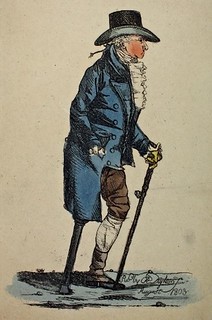 When you think of the Bank of England, you don't often think about shark attacks. But perhaps that's because we've yet to introduce you to Sir Brook Watson (1730-1807), merchant, politician, and Deputy Governor of the Bank of England.
When you think of the Bank of England, you don't often think about shark attacks. But perhaps that's because we've yet to introduce you to Sir Brook Watson (1730-1807), merchant, politician, and Deputy Governor of the Bank of England.
Born in Plymouth, Devon in 1730, Watson worked on his uncle's merchant ship from the age of 14, trading between Massachusetts and the West Indies. While the ship was in Havana, Cuba, Watson went swimming in the harbour and was attacked by a shark. He was rescued by his crew-mates, but was so badly injured that his right leg had to be amputated.
Incredibly, Watson survived not only the shark-attack and nearly drowning, but also receiving emergency surgery on a ship in the 1700s! For the rest of his life, he walked with the aid of a wooden leg.
Emboldened, perhaps, by surviving the shark attack, Watson went on to have a career as a merchant and army official during times of great political change. In 1772 he was one of the founding members of Lloyds of London, and conducted business between the United Kingdom and Revolutionary America. In 1775, however, he was accused of spying for the British, making for a speedy return to London.
... in 1778 he commissioned American artist John Singleton Copley to paint the attack in the style of a history painting. Watson saw the attack as a moment of personal salvation, and wanted to immortalize it. The painting, Watson and the Shark, is now one of the highlights of the National Gallery of Art in Washington D.COpens in a new window.
Watson went on to become a prominent figure in the City of London. He became a Member of Parliament for the City of London in 1784, and was appointed as Lord Mayor in 1796. He also served as a Director of the Bank of England from 1784, and eventually as a Deputy Governor from 1806 until his death the following year.
To read the complete article, see:
The Life and Times of Sir Brook Watson
(https://www.bankofengland.co.uk/museum/blog/the-life-and-times-of-sir-brook-watson)

BABY CAS PHYSICAL BITCOIN BRINGS $1.698M
In a press release, GreatCollections announced the sale of a 25-bitcoin denominated physical coin. -Editor
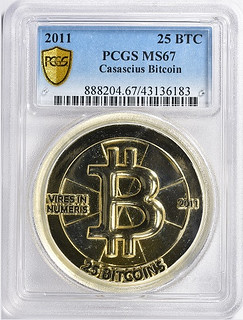 The
The Baby Cas
, a 25 BTC physical coin issued by Casascius in 2011 realized $1,698,750 at GreatCollections on Sunday, after over 100 bids were received. Total sales for the single day of auctions exceeded $5.25 million.
The physical Bitcoin, graded MS-67 by PCGS, attracted the attention of over 200 bidders who were actively tracking the auction, with over 10,000 page views. The final price represented a $49,700 premium over the price of Bitcoin at the time that bidding ended.
The 25-Bitcoin Baby Cas
was graded by PCGS alongside the holy grail of crypto physical coins — the Gold Cas
, a one-ounce gold Casascius coin with 1,000 Bitcoin, or BTC. The current value of the Gold Cas
exceeds $60 million and is by far the most valuable coin in the world, despite being issued only 10 years ago by a private company.
Casascius, the company created by Mike Caldwell, issued physical bitcoins from 2011 to 2013 in various denominations from 0.1 BTC to 1,000 BTC (the Gold Cas
). Over 800 of the 25 BTC denomination coins were produced, and less than half of that remain unredeemed.
Ian Russell, president of GreatCollections said:
"As expected, there was a significant amount of bidder interest for the most important physical Bitcoin ever to appear in auction. We had new bidders register from 14 countries specifically for the Bitcoin auction, not to mention the interest from the traditional numismatic community."
It was the second most valuable coin GreatCollections auctioned this year. The finest 1893-S Morgan silver dollar realized $2,024,024 in August — an all-time world record for a Morgan dollar. Also in August, GreatCollections reported being the winning bidder for three of the most valuable U.S. coins to ever appear in auction for over $21 million — the finest 1804 silver dollar, the tied-for-finest 1794 silver dollar, and finest of two known 1861 Paquet gold double eagles.
To read the complete article, see:
Casascius Bitcoin sells for $1.69 million at GreatCollections
(http://news.coinupdate.com/casascius-bitcoin-sells-for-1-69-million-at-greatcollections/)
CLASSICAL NUMISMATIC GROUP TRITON XXV SALE
Here is the press release for Classical Numismatic Group's January NYINC sale, Triton XXV. -Editor
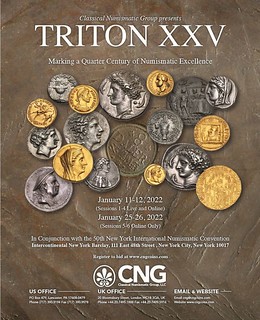 Marking a quarter-century of numismatic excellence, Classical Numismatic Group
LLC's Triton XXV Auction in New York City Jan. 11-12 and Jan. 25-26, 2022 will bring to the block nearly 3,000
masterpieces of Ancient Greek, Judean, Roman, World and British coinage, according to CNG Managing
Director Michael Gasvoda.
Marking a quarter-century of numismatic excellence, Classical Numismatic Group
LLC's Triton XXV Auction in New York City Jan. 11-12 and Jan. 25-26, 2022 will bring to the block nearly 3,000
masterpieces of Ancient Greek, Judean, Roman, World and British coinage, according to CNG Managing
Director Michael Gasvoda.
We were hoping to assemble a great auction to mark Triton's twenty-fifth anniversary,
Gasvoda said,
and with this monumental offering, it's mission accomplished!
Among the high-value coins to be offered are a magnificent silver dekadrachm of Syracuse, circa 405
BC, signed three times by the master engraver Kimon and pedigreed to the Bibliothèque Nationale de France;
an Attic-weight silver tetradrachm of the legendary Indo-Greek King Menander, one of only two known; a
major offering of Biblical-related coins, including an extremely rare Year 5 Shekel of the first-century Jewish
War against Rome, two of the rare and famous bronze menorah coins
of King Matathias Antigonus, and an
impressive bronze medallion 217 depicting the Biblical Noah's Ark, one of only three known examples; and a
huge and impressive piece of Swedish plate money with a stamped value of 8 Daler, dated 1659. Triton XXV
also includes more than 90 Roman gold coins, including several highly important rarities; a rare and historically
significant Umayyad gold dinar dated Year 77, the first year of issue; and a rare silver denarius of the rebel
Roman general Labienus.
The Triton series of auctions commenced in New York on December 2, 1997 in conjunction with the New York International Numismatic Convention (NYINC) and has continued in an unbroken yearly sequence since then, making it one of the longest-running major numismatic auctions in the field of Ancient, British and World coins. Sessions 1 through 4 of Triton XV will be held prior to the 50 th annual NYINC, scheduled at the Intercontinental New York Barclay Hotel, 111 E. 48 th Street, New York NY, January 13-16.
With the total presale estimate exceeding $7 million, Triton XXV is anchored by several spectacular
collections, said Gasvoda. Among the these holdings are the collection of Dr. Jay Galst, a New York opthalmologist who spent five decades collecting ancient Judaean and related coinages; the Melinda
Collection, focused on Hellenistic masterpieces from the Greco-Baktrian and Indo-Greek civilizations; The
Archytus Collection, an important offering of ancient coinage from the Indian subcontinent; the Thomas A.
Palmer Collection, a stellar group of Roman Imperial Silver denarii; the DeWilde Collection, a remarkable
holding of Dutch rarities; and the DMS Collection of important Swedish coins.
Artistic excellence, historical importance and extreme rarity abound in the offering, the first four sessions of which will be held as live floor auctions at the Barclay Intercontinental Hotel in New York City, Tuesday and Wednesday, January 11 – 12, 2022. Triton's Fifth and Sixth Sessions will be conducted live on the internet from CNG's headquarters in Lancaster, PA, on Jan. 25 and 26. All coins may be viewed at the Barclay starting Sunday, January 9, at 1 pm through the auction dates.
Bidders may view and participate remotely in all sessions of Triton XXV via the company's website, www.cngcoins.com. To receive a printed copy of the full-color catalog and a detailed schedule, contact Classical Numismatic Group LLC at CNG@cngcoins.com, or call (717) 390-9194.

DAN FREELAND MICHIGAN NATIONAL BANK NOTES
Lyn Knight Auctions is selling the Michigan National Bank Note collection of Dan Freeland. His wife Kathy wrote this bio for the catalog and we're publishing it here with permission. -Editor
Dan Freeland, (born on Nov. 4, 1949) was a man of many interests. The oldest of three boys, Dan graduated from Mayville Community Schools in 1967, after attending country school for a number of years, then from Central Michigan University with a Bachelor of Science degree with an emphasis in mathematics in 1971. He began teaching in Millington in 1972, enjoying 30 years of mathematics education before he retired. He was the geometry teacher for most of those 30 years, and to this day, I have students who tell me that they had Mr. Freeland for geometry class! Even then, he had a keen interest in numismatics, starting to collect coins in 1961 when he was 12. His students used to say that if they wanted to get Mr. Freeland off the topic of math, all they had to do was bring up coin collecting and ask questions, and it worked every time.
Dan was a member of the Mayville United Methodist Church his entire life, and his faith was very important to him as was serving others. Dan loved his hobbies, which included playing cribbage, double pinochle, collecting Hallmark ornaments and traveling (as long as it was by car). He even owned a motorcycle that he enjoyed riding and attempted to play golf (I have great stories to tell from his friends), but numismatics was the top hobby right up to the end. Even though he started off with coins, his collecting interests were many, as were his memberships in various organizations. He always found ways to give back to the hobby, including serving on the Michigan State Numismatic Society board for a number of years, belonging to the Flint Flying Eagle and Marysville Coin Clubs and being Secretary/Treasurer of the Paper Money Collectors of Michigan.
He collected coins (US Commemorative coins, Canadian coins, proof sets and mint sets). He also assembled collections of a variety of different tokens and medals, including Krause Publications related medals, tokens and ephemera, national commemorative medals, Society of Medalist and Heraldic Art medals, and many different types of tokens, including Civil War storecards related to Michigan, trade tokens, Gallery Mint and OHNS tokens and transportation tokens, among others. While he concentrated on nationals, he also collected Canadian Tire company notes (thanks to a trip through Sarnia to Stratford), JGS Boggs and Prusmack notes, and souvenir sheets from ANA, CSNS, and SPMC. We were both a part of the MPCFest group, serving as the coordinators for the scholarship fund that sends people to Colorado Springs for ANA classes, and he collected military notes as well, ranging from WWII war savings certificates to war bonds to POW chits and others. And…did I mention that we had all the books to go with the collections?
The collection he was proudest to own is what you will see here – his Michigan National banknotes collection, which he said took him 30 years to complete. And not only did he collect the banknotes, he collected all the other stuff to go with it – small banks, rulers, and other advertising items associated with many different names of the banks, with probably the most extensive collection being of the Second National Bank of Saginaw.
 He enjoyed going through antique stores looking for these items along with
postcards of the various banks and many other items he used to build displays. Ebay
was his friend as he got older, and he was able to find a number of things through their
auctions, using a number of searches to find the
He enjoyed going through antique stores looking for these items along with
postcards of the various banks and many other items he used to build displays. Ebay
was his friend as he got older, and he was able to find a number of things through their
auctions, using a number of searches to find the juicies
as he called them. He was
also able to find items through different currency dealers and auctions, including those
of the collections of Dr. Wallace Lee and Bill Rau, the Steve Davis auction of Jack Lavis'
collection, including a sheet of 4 $10 notes and a $20 note that was probably the last
one he purchased.
One of his greatest accomplishments, at least from my viewpoint, were the talks he gave about many of his collections. While he was a quiet man, the love he had for teaching and collecting was very evident in his talks, which ranged from the paper money he collected to all things Christmas, and in his exhibits which yielded many awards, including 4 Best-of-Shows, the first being in Pittsburgh in 1989, his first National ANA Show! For the last four months of his life, we had therapy people at our home, and Dan's greatest joy, combining his love of teaching and numismatics, was to show them some of the things he collected, especially his notes, and get them excited about collecting them as well.
Dan and I enjoyed many years of marriage (we would have celebrated 28 this October) and while he is sorely missed by many, I know that he is remembered for his passion, his kindness to others, and his work in the hobby.
I've illustrated this article with selected notes from the collection. here's more information from Lyn Knight. -Editor
We are pleased to announce the sale of the Dan Freeland Collection of Michigan National Banknotes. Dan built this collection featuring towns and banks that he cared about. It is a lovely offering including nearly all types and even uncut sheets. This sale will be held on KNIGHT LIVE December 8 at 1 PM CST.
To bid in the sale, see:
Dan Freeland Collection of Michigan National Banknotes
(http://www.lynknight.com/catalog_sessions/1772)
To read the earlier E-Sylum article, see:
DANIEL ALLEN FREELAND (1949-2021)
(https://www.coinbooks.org/v24/esylum_v24n22a06.html)

WORLD BANKNOTE AUCTIONS LIVE SALE 18
Here's the press release for World Banknote Auctions' new website and Live Sale 18. It closes December 2nd. -Editor
World Banknote Auctions presents new website and Live Sale 18.
World Banknote Auctions has launched a new homepage on its website. The new home page allows a number of different functions, including the opportunity to learn more about the company, a blog, and a direct download of the consignment form.
This updated website allows us to feature a lot more banknote relatable content, such as news
items and blogs featuring specific lots and collections
says Dennis Hengeveld, President of
World Banknote Auctions. The company will use the new page to feature upcoming auctions,
past sales results, and make it easier for its customers to learn more about consigning items to an
upcoming sale. The bidding platform has remained the same and users that previously signed up
for the website can continue to log in with their username and password.
This week World Banknote Auctions launched Live Sale 18, which takes place on December 2nd at 10 AM PST. As usual, live bidding will take place on the website and on its mobile apps. The sale features 553 lots of graded world paper money crisscrossing the globe and featuring items both for beginning and advanced collectors alike.
Lot 18307 is a PMG graded Choice Very Fine 35 example of a Malaya 1942 100 Dollars, Pick- 13. Despite a comment from the grading service for minor rust, it faces up better than most other examples that have recently appeared at auction. This large-size note typically comes in lower grades or with major problems and this example is fresh to the market. The lot carries a pre- auction estimate of $4,000-$5000.
Lot 18377 is a PMG graded Superb Gem Uncirculated 67 EPQ 1000 Escudos from Portugal
(Pick-166). Dated 1961, this colorful banknote is tied with just one other example for the finest
in the PMG population report. The auction descriptions states One of Portugal's most beautiful
banknotes and a very rare type in high grade
. It carries a pre-auction estimate of $1,500-$2,000.
Lot 18388 is a PMG graded Superb Gem Uncirculated 67 EPQ 1 Pound dated 1960 (Pick-21a) from Rhodesia & Nyasaland. Tied for the finest in the PMG population report, this is an extremely popular series, which was issued for a British Colonial Federation that today are the modern-day nations of Malawi, Zambia, and Zimbabwe. This note features a portrait of the young Queen Elizabeth II and carries a pre-auction estimate of $3,000-$4,000.
Lot 18401 is a PMG graded Very Fine 25 graded 3 Rubles 1894 (Pick-A55) is part of a small but select group of classic Russian banknotes. Pre-1898 Russian banknotes of any denomination are very scarce, and this example of the popular 3 Rubles denomination is no exception. It carries a pre-auction estimate of $2,000-$3,000.
These and all other lots on the auction are open for bidding now and can be viewed on www.worldbanknoteauctions.com. Registration is free of charge and the auction company charges a modest 15% buyer's premium ($5 minimum) and flat-rate shipping charges worldwide. Payment is possible via credit card, wire transfer, or check.
NUMISMATIC NUGGETS: NOVEMBER 21, 2021
Here's a selection of interesting or unusual items I came across in the marketplace this week. Tell us what you think of some of these. -Editor
(18mm, 6.35g) Two male heads, side by side with one inverted. Rev: Sea-eagle standing left on dolphin. Sear-1669 variety; gVF/aVF, reverse off struck, harshly cleaned
Cool piece. From the Geoffrey Bell November 2021 sale. -Editor
To read the complete lot description, see:
MOESIA, Istros. 400-350 BC. AR Drachm
(http://auctions.gbellauctions.com/MOESIA-Istros-400-350-BC-AR-Drachm_i43579734)
1883 Harrison Brothers and Company's Town and Country Ready Mixed Paints Advertising Note. 3.125 in. x 7 in. Intended to promote sales, Harrison Brothers and Company's advertising note entitles holder to one gallon "and upwards" of Harrison's "Town & Country" ready-mixed paint. Printed to look like a banknote with a scale, monograms and formulation information incorporated into the design. Also known as the Harrison Brothers Chemical Works and the Grays Ferry Chemical Works, this chemical manufacturer was an originator of ready-mix paints for the consumer market. Philadelphia & New York. Small tear at bottom left corner.
From the ANA Money Museum eBay sale. -Editor
To read the complete lot description, see:
1883 Harrison Brothers and Company's Ready Mixed Paints Advertising NoteListed for charity
(https://www.ebay.com/itm/313758501482)
Bread tokens, Warringah Bakery Pty Ltd and predecessor Maisey, Mona Vale, a series of mint specimens in aluminium (11) and bronze (10), probably restrikes, eight are muled, two square half loaf are with "Amor/Sydney" in two lines. Uncirculated. (21)
Ex Mark E.Freehill Collection, from L.J.Carlisle and R.J.Byatt.
From the November 23, 2021 Noble Numismatics sale. -Editor
To read the complete lot description, see:
Lot 431: Miscellaneous Tokens & Checks
(https://www.invaluable.com/auction-lot/Miscellaneous-Tokens-Checks-431-c-38249A1A81)
T-1. Confederate Currency. 1861 $1000. PMG Very Fine 20 Net. Restoration, Stains.
No. 181, Plate A. The key note of the "Big Six" of Confederate currency, just 607 of these 1861 $1000s were issued and today just around 150 are known to survive. These National Bank Note Company produced notes are immediately recognizable for their brilliant green tints. The portrait of John C. Calhoun appears at bottom left while Andrew Jackson is seen at bottom right. Intricate counters occupy the top corners. These $1000 notes, as well as the first $500s, $100s and $50s were issued while the Confederate capital was located in Montgomery and thus they are known as "Montgomery notes". This note is found without punch cancellations. PMG comments "Restoration, Stains."
I was fortunate to have a couple Montgomery notes in my Civil War collection, but I didn't have the $1,000. From the Stack's Bowers November 2021 U.S. Currency sale. Great opportunity to acquire an interesting, rare, and historically important banknote. -Editor
To read the complete lot description, see:
T-1. Confederate Currency. 1861 $1000. PMG Very Fine 20 Net. Restoration, Stains.
(https://auctions.stacksbowers.com/lots/view/3-TXE6N/t-1-confederate-currency-1861-1000-pmg-very-fine-20-net-restoration-stains)
THE BOOK BAZARRE
WAYNE'S NUMISMATIC DIARY: NOVEMBER 21, 2021
NUMMIS NOVA
On Tuesday November 16 I got moving early in the morning as usual, with a case of bedhead of Warholian proportions. Someday I'll take a selfie. But I pulled it all together, made myself presentable for work and headed to my office.
It was a productive day and afterwards I happily pointed my car toward McLean, VA where a meeting of my northern Virginia numismatic social group Nummis Nova awaited. Roger Burdette was our host and he'd made a dinner reservation at J. Gilbert's, a great steak & seafood house.
Tom Kays was the first to arrive and I walked in right behind him. We grabbed stools in the bar to wait for the others. Soon Dave Schenkman, Eric Schena, Chris Neuzil and Wayne Herndon arrived. Before long Roger came in, settled some confusion over the reservation, and soon we were all walking back to a private room.
I'm a terrible photographer, but at least this shot was amusing.
I sat across from Roger at one end of the table and someone managed to cut him off of most of the group photos I took. Like I said, terrible photographer. Blame the glass of wine in the foreground. Anyway, clockwise from front left are Mike Packard, Chris Neuzil, Tom Kays, Daryl Haynor, Julian Leidman, Steve Bishop, Wayne Herndon, Dave Schenkman, Eric Schena and Roger Burdette's arm.
Wayne's Show-N-Tell
A few meetings ago I brought along some of my collection of works by "Money Artist" J.S.G. Boggs. This month I brought a framed piece from his 1993 "Magic Money Machine" performance in Indiana, PA.A more recent acquisition for my numismatic library was a copy of The Fantastic 1804 Dollar inscribed by Ken Bressett to Walter Breen. I also brought along some Breen letters and article manuscripts.
Other items included ephemera from last month's PAN show and the new book on physical bitcoins. These are pictured below in Tom Kays' writeup.
Eric's Ephemera
Eric surprised me with some gifts for my numismatic ephemera collection - a couple copies of the 1990 Harrisburg Coin Club show program, and a 1976 Stack's ANA auction catalog printed by Coin World. By its very nature ephemera typically gets used once and discarded, often making the formerly common quite rare. These particular items may never be valuable but they make interesting additions to a collection. Thanks, Eric!Bob Hendershott's Wooden Nickel
Dave Schenkman shared this "50mm wooden piece issued by Bob Hendershott. It is signed by him and dated 8-7-98, which was the last day of the Portland ANA convention."I got to meet Bob a few times at ANA conventions. He passed away in 2005 at the age of 106. He was one of the founders of the Florida United Numismatists, Inc. in 1955, and attended the 1904 St. Louis World's Fair in person as a 6 year old. This spurred conversations about other long-lived numismatists such as Eric P. Newman, who also reached the 106 milestone.
To read earlier E-Sylum articles, see:
ROBERT L. HENDERSHOTT, 1898-2005
(https://www.coinbooks.org/esylum_v08n13a02.html)
BOB HENDERSHOTT AND THE 1904 WORLD'S FAIR
(https://www.coinbooks.org/esylum_v08n13a03.html)
VIDEO: INTERVIEW WITH ROBERT HENDERSHOTT
(https://www.coinbooks.org/v23/esylum_v23n20a13.html)
1778 North Carolina Eighth of a Dollar Note Dave also brought along some great paper items.
Dave has written an article about the printer of this note (he was the first printer in North Carolina) due for publication in the January 2022 issue of ANA's The Numismatist.Ohio & Kentucky Coal, Iron & RR Co. Notes
Dave writes:"I purchased these two notes in a recent auction. They are the rarest of the known notes from this company. I'd be interested in hearing from anyone owning a five cents denomination. I've never seen one, and Earl Hughes doesn't list it in Kentucky Obsolete Notes and Scrip."
Tom's Table Talk
Tom Kays submitted this photo and writeup of his experience at the dinner. Thanks!
Our ‘saintly-appearing' host Wayne lights up the bar with a stained-glass halo of hearty welcome.
Nummis Nova members met at J. Gilbert's Steak House in McLean, Virginia for their November dinner. In person meetings seem to be rare events these days, made all the more fun by their infrequent nature. We were ushered from waiting at the bar back to our usual private room, in order not to disturb normal steakhouse diners with our ribald coin talk and numismatic shenanigans, a wise choice.
The first numismatic morsel to appear at table from our grandiloquent host Roger, was photocopy of a letter written in 1877 to O. H. La Grange, Superintendent of the U.S. Mint at San Francisco, regarding an odd double dime. The 1875 dated 20-cent piece in question had a reeded-edge and not the normal plain-edge. The writer, Director of the Mint, HR Linderman, wanted to know if it had been tampered with, or perhaps it might have been one of the first struck, something like a pattern piece? He enclosed the coin and asked for its return regardless of the answer. Do any legitimate 1875-S, reeded-edge 20-cent pieces exist? The letter raises questions to ponder.
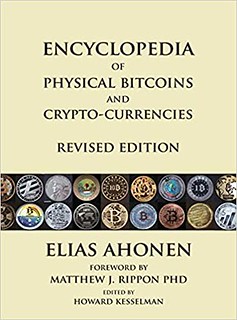 Next at table came the Encyclopedia of Physical Bitcoins and Crypto-Currencies by Elias Ahonen
which raises even more questions about types of wealth undreamed of, back when silver, 20-cent pieces
circulated. And then I saw The Art and Craft of Coinmaking – A History of Minting Technology by Denis
R. Cooper, a former Superintendent of the Royal Mint which floated by. This is a scarce book from the
1960s with a letter about D. R. Cooper's new digs at the London Office of Taylor & Challen Limited, St.
Stephen's House, Victoria Embankement, where he continued with consulting in the design and supply
of minting machinery.
Next at table came the Encyclopedia of Physical Bitcoins and Crypto-Currencies by Elias Ahonen
which raises even more questions about types of wealth undreamed of, back when silver, 20-cent pieces
circulated. And then I saw The Art and Craft of Coinmaking – A History of Minting Technology by Denis
R. Cooper, a former Superintendent of the Royal Mint which floated by. This is a scarce book from the
1960s with a letter about D. R. Cooper's new digs at the London Office of Taylor & Challen Limited, St.
Stephen's House, Victoria Embankement, where he continued with consulting in the design and supply
of minting machinery.
Next a framed J. S. G. Boggs ‘Boggs Bill' listing Wayne K. Homren as Treasurer of
United States Art
passed in review. Its serial number (16061993) made it extra special as a date note
from June 16, 1993. It is an ‘error note' with mismatched serial numbers as well, but you might expect
such surprises from high art.
Eric sent along a Shenandoah Apple Blossom Festival Lucky Encased Cent from Winchester, VA with a high grade 1931 Lincoln Cent enclosed. This comes from a ‘local' site next door to his house, associated with the long traditions of the Town of Winchester and with Patsy Cline the country singer and a hometown girl.
You may appreciate the diversity and depth of interest that we all bring to dinners by what we think
worthy of show-and-shares.
Everything has a story to tell. Along came The Fantastic 1804 Dollar by
Eric Newman and Kenneth E. Bressett with a dedication page written to Walter Breen in 1962. This
started much discussion about Walter Breen and his wife, the noted author Marion Zimmer Bradley,
author of The Mists of Avalon.
A dinner menu from the recent Annual Fall Banquet of the Pennsylvania Association of Numismatists (PAN) combined both coins and dinner in a wonderful manner, having been pasted into blue Whitman coin folders by Tom Uram to celebrate the Centennial of Morgan/Peace Dollars of 1921 by reissue of both in 2021.
Assortments of random numismatic objects began whizzing past quickly before the appetizers and bread and butter were served, as we do not want greasy fingerprints on our treasures. The feeling is something like opening the door of Doctor Who's TARDIS, not knowing where or when the next thing you see hails from.
Piling up on my right was a collection of miscellany including a post card with an image of The World's Greatest Travel Car, a Model-T sporting a coin shop on wheels in its bed, then North Carolina Colonial Currency from the Eric P. Newman Collection including a note signed by notable, James Davis in 1778. Also a ten-dollar Boone Furnace - Coal, Iron, and Railroad Company note from Kentucky of 1874 and then ‘A Round TUIT wooden nickel issued in Portland, Oregon in 1998 by Robert L. Hendershott, Numismatist and Expert on the 1904 Saint Louis World's Fair appeared, followed by a catalog from the Tyrant Collection of U.S. Type Coins – The World's Most Valuable Private Coin Collection.
I saw fine old silver coins (New Purchases or NEWPs
) including French Diximes and
Douzains of Louis XIV and XV, old Spanish cobs, pillars, and portraits from Philip III to Ferdinand VII, full
and half Leeuwendaalders of the Low Countries ("How low were they?" someone asked) and some early
U.S. coins including bust Half Dollars among other numismatic objects of note, each having a tale to tell,
but not having time enough to share all their stories before the hungry dinner crowd dug in.
Personally, I no longer bring such commonplace things as two-headed large cents to show and share, since the normal ambiance of fine dinner lighting keeps their ruddy copper toned oddities in the dark. In fact, I brought and wore a hands-free, head mounted LED Miner's Lamp during the pre-dinner round-to be able to see and be able to tell you all about the curiosities passing along my end of the table, all the while minding not to glance up and blind my cross table dinner partners when they spoke. Sorry Wayne!
I talked at length with Wayne Herndon (the other Wayne) of Wizard Coin Supply who told of how the
U.S. Mint Fulfillment Center in Memphis, Tennessee sent him a sealed truck and dedicated driver, to
carry a single pallet, slightly filled at the bottom with his American Innovation Dollar coin order. While
well worth the $4.95 shipping charge, the delivery failed to come with keys or instructions on how to
open the steel-bar reinforced, official U.S. Mint Seal locking the back of the truck, used to keep the
driver, or anyone else from tampering with the order en route. Hammers and crow bars would not cut
it, so that you will have to ask Wayne for how this story involving innovation
turns out.
By now food orders were assembled and entrees appeared, causing us to put show and shares away and stifling our conversation to a polite, mouth-filled standstill, while we supped on steaks and sundries. Now this is what a Nummis Nova dinner should do. Fill us with stories of numismatic variety and with gustatory delight. After a fine steak dinner the rest of the evening was a pleasant blur of digestion and camaraderie with ever intruding thoughts of returning to the real world tomorrow morning. Some of us needed to drive large commercial vehicles loaded with coin supplies to the Whitman Coin Show in Baltimore for dealer set-up at a major sales event the next day. Such is the life of the coin enthusiast.
Wrapping Up
Thanks, Tom. Here's a shot I took after dinner from the other end of the table. Clockwise from left: Julian Leidman, Steve Bishop, Wayne Herndon, Dave Schenkman, Eric Schena, Roger Burdette, Mike Packard, Chris Neuzil, Tom Kays (in the dark) and Daryl Haynor.WHITMAN BALTIMORE EXPO
My numismatic adventures for the week were only beginning. After a morning meeting at the office I headed up to Baltimore for the Whitman Expo. One of my first stops was the table of Sheridan Downey - he's compiling electronic files of his catalogs and pricelists for the Newman Numismatic Portal.
I also ran into NBS Board Member Dave Steine, who was speaking with Doug Winter at Doug's table. We discussed the utility and value of priced and named auction catalogs and whether their presence on NNP reduces their value. While it does remove some otherwise interested buyers from the market, Doug and I were in the camp of those interested in physical copies as a tangible connection to the hobby's past. Much as I love the Portal, in the end it's just a photo album with pictures of things we bibliophiles value - there's no substitute for the real item.
Other NBS Officers I spoke to at the show were David Fanning and Len Augsburger. I caught up with David at the table of John Kraljevich and helper Erik Goldstein. The four of us would have dinner that evening along with Charlie Davis and Neil Musante. We had to scramble when I learned that Sullivan's, where Len and I often dine, was closed. And Morton's was booked until nearly 8pm. With JK's help we found a nice Italian place a few blocks up Charles Street.
But I digress. My main mission was to make the rounds and visit our E-Sylum advertisers; we couldn't keep this going without their support. Doug Winter has been a stalwart from the beginning of our HTML era, when we could include images and offer more than just text-based ads. In addition to Doug, David and Charlie, at the show were Harry Laibstain Rare Coins, Julian Leidman, Bob Rhue, Northeast Numismatics, Dave and Melissa Kahn, Pierre Fricke, Daniel Frank Sedwick, Classical Numismatics Group, Dennis Hengeveld of World Banknote Auctions, Jeff Garrett, and more.
Some folks were not at their tables when I stopped (David Michaels of CNG, and Bob Rhue, for instance), but others were just busy with customers (such as Dennis Hengeveld, Pierre Fricke and Don Kagin). I spent much of my time talking with others between customers, and didn't get around to taking many photos.
Among the advertisers and other friends I spoke with at the show were Julian Leidman, Chris Neuzil, Rick Lank and Becky Rush, Dave Lange, Jesse Kraft of ANS, Dan Friedus, Charlie and Neil, Alan Weinberg, Julia Casey, Chris McDowell, and Melissa Kahn. Somehow I managed to miss Wayne Herndon's table.
One unplanned interlude occurred at the back of the hall where I heard a noise and turned to see that a showgoer had fallen onto the concrete floor. A wheeled cart was caught on the leg of a chair and may have been what caused him to lose balance. Four or five of us managed to lift him up and onto a chair. It took every last one of us - the guy must've weighed 300 pounds. Expo Center security staff came quickly and were quite professional. They helped the man get back on his way.
Daniel Frank Sedwick
A couple of the few photos I took were at the table of Daniel Frank Sedwick, LLC. I had nice conversation with him and Augi Garcia about their recent sale and the state of the numismatic market.We'd recently discussed Global Certification Services holders and I came across this one in one of their cases. I also had a conversation with Jeff Garrett about these - see his note about these elsewhere in this issue.
To read the earlier E-Sylum article, see:
QUERY: GLOBAL CERTIFICATION SERVICES
(https://www.coinbooks.org/v24/esylum_v24n46a13.html)
Jeff and Mary Lynn Garrett
One of the last tables I visited was that of Mid-American Coin Galleries, where Mary Lynn and Jeff Garrett were just closing up shop.
Dinner and Farewell
Our dinner was at Sotto Sopra. Len and I walked the few cold blocks up Charles where John, Erik and David were already seated at a back table. Neil and Charlie joined us a bit later.
Conversation flowed about numismatics, the show, and everything else in the world. Everyone speculated on the meaning of the "Women's Exchange" building sign on Charles street - "How exactly does that work, anyway?" Turns out the Woman's Industrial Exchange of Baltimore City had been in operation there for 140 years, providing work and assistance for needy Baltimore women.
Having awoken at 4am it had been a long day for me. It was a great show and dinner, but I marched back to my car for the hour-long drive home. I'll look forward to seeing people again at the next major show.

THE LIBERTY SEATED CENT PATTERN
In the November 2021 issue of E-Gobrecht, the newsletter of the Liberty Seated Collectors Club (LSCC), Len Augsburger discusses an interesting pattern coin - the 1854 Liberty Seated Cent. -Editor
Pitter Patter About Patterns
Liberty Seated collectors tend to not discuss pattern coins, and it's understandable why. They are expensive, and no one is going to see cases full of pattern coins at a typical coin show. More typically you see a piece here and there in dealer offerings, perhaps a small group if a dealer specializes in patterns, but such dealers are few and far between. Even if pattern coins are generally available, no one is quite sure how to collect them. It's not like Whitman issues a coin folder with a list of the ones you are supposed to acquire.
Some years ago I came on the idea of collecting one each of every major design type within the Seated
quarter pattern series. It's about seven or eight coins. Probably I was influenced by the old saying that every
collection should contain at least one pattern coin. You can be sure that saying was made up by someone who
had pattern pieces to sell. In any event, I bought the first coin from a self-proclaimed market maker
in the
series, a nice toner in PR66. I gave up on the series after a few failed attempts to acquire some of the tougher
pieces, which exist in single-digit quantities. The PR66 got offered back to the dealer who sold it, and failed to
attract even a lowball offer. So much for market maker
status. I put the piece in a Heritage sale and took a
$100 loss on it. In my view the $100 represented the cost to rent
a rare coin for a few years.
Today I own only a single pattern piece, a Judd-158 1854 pattern cent that features the Liberty Seated
design. The workmanship is crude and represents an intermediate step in the die production process. Reduced by a lathe from an 1854 dollar die, the die bears circular lathe marks that, in normal production, would
be smoothed out. I enjoy the piece as a curiosity – who ever heard of a Liberty Seated cent?
These dies
were produced in order to test different alloys for coining, none of which were adopted, and the coiner was
more interested in testing different compositions than in producing neatly finished dies.
For more information about the Liberty Seated Collectors Club, see:
http://www.lsccweb.org/
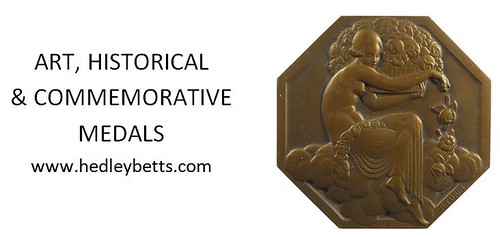
A TAEL OF EMERGENCY CHINESE MONEY
Nicholas Fritz of Stack's Bowers published this article about two interesting French Indochina emergency coins. -Editor
In our December Hong Kong Collectors Choice Auction? there are several 1943-44 Yunnan Taels minted in French Indochina for circulation in the Chinese province of Yunnan. Chief among these is lot 41618, an example graded AU-58 by PCGS.
In 1943 French Indochina was in a very unsettled political situation. In 1940 France fell to the invading German army, leaving the French colonial situation very much in doubt. The end of the Third Republic led to the creation of a divided France. In the north of France along the Atlantic coast, the German army occupied a large swath of territory as a militarized zone against any attempted allied landings. The south of France, though still with a German presence, established a provisional government at the spa town of Vichy that gave essentially dictatorial powers to Marshall Philippe Petain, hero of Verdun in the First World War. This Vichy government, though decried as a puppet of the Germans, continued to administer many functions without direct supervision, including running France's colonies. In the South Pacific, the colony of French Indochina was targeted by the ever-aggressive Japanese. The Vichy regime, in no position to negotiate, was forced to accept Japanese naval access in the Gulf of Tonkin.
It was against this backdrop that these Silver Taels were struck in French Indochina at the Hanoi Mint from dies engraved by Rene Mercier. The obverse features the head of a stag, and the reverse is inscribed, reading: One Liang Guaranteed Silver One Ounce, a very plain design on what is essentially an ingot of silver. In addition to these stag Taels, another type offered in lot 41612 features the Chinese character for wealth; this design was also produced in a half-Tael denomination. According to Kann, these types were likely used to pay Chinese soldiers on the Burma front. China itself was at war with Japan, and though Yunnan was not directly occupied, it became flooded with refugees and soldiers fleeing or fighting Japanese expansion. In China, and Asian generally, any form of silver was widely accepted in commerce. It has also been rumored that these were produced to facilitate the opium trade, which was probably supported by many soldiers. The transitory nature of the population increased when Japan occupied the whole of French Indochina in 1945 after the defeat of Nazi Germany. The brutality of the Japanese occupation sparked an independence movement in French Indochina that led ultimately to the creation of Vietnam. These issues were among the last products of the Hanoi Mint under French, or perhaps quasi-French, rule. The Taels and half-Taels offered in the December Hong Kong Auction should spark strong crossover interest for those interested in Chinese, French Indochina, and World War Two issues.
The over 2,000 items making up the Stack's Bowers Galleries December Hong Kong Auction are now available for viewing and bidding at StacksBowers.com.
To read the complete article, see:
A Tael of Emergency Chinese Money
(https://www.stacksbowers.com/News/Pages/Blogs.aspx?ArticleID=tael-emergency-chinese-money)

RARE WWI DISTINGUISHED FLYING CROSS MEDAL
This article discusses a rare WWI medal seen on the Antiques Roadshow. -Editor
Antiques Roadshow aired a classic World War One Special episode on Sunday evening to mark Remembrance Day. The BBC One programme featured several antiques that dated back to the First World War. However, there was one in particular that caught the eye of military museum curator Mark Smith. He was amazed when one guest brought in an extremely rare Royal Air Force medal.
In the episode, a guest brought in a collection of items that had once belonged to a First World War pilot.
Gesturing towards a picture of the pilot, the guest said: This is James Victor Gascoyne, a lovely man who sadly passed away in 1976.
He joined the Royal Flying Corps in 1913,
the guest explained.
13?
Mark exclaimed, stunned by the early date. So, this is before the first world war? Almost as the Royal Flying Corps was formed.
Yes, he was one of the early ones. His collar number was 719,
the guest revealed.
Mark explained: They were actually in numerical order, so he's the 719th man to join.
The expert continued: Now, he was quite successful. There's a thing in the Royal Flying Corps or the Royal Air Force as it became on the 1st of April 1918, which is that if you shoot down five of the enemy, you get something called ‘Ace status'.
He was an ‘Ace' wasn't he?
Mark said, with the guest confirming: Yes, he was.
As he examined the medal, Mark explained: Now, in 1918 this is a very new award because the Royal Air Force was only born in April of that year.
"They needed a medal which equated to the Military Cross for the army and the Distinguished Service Cross for the navy.
They came up with, I think, one of the most beautiful medals for gallantry, the Distinguished Flying Cross.
But, this one has the very rare striped ribbon instead of the diagonal that we're used to, which came just after that,
he revealed.
To read the complete article, see:
‘You don't see those!' Antiques Roadshow expert in awe of rare First World War medal
(https://www.express.co.uk/showbiz/tv-radio/1521362/Antiques-Roadshow-rare-First-World-War-medal)

BANKNOTES OF NEW ULM, MINNESOTA
It's always nice to see mainstream publications discussing numismatic topics. The Journal of New Ulm, Minnesota just published a nice article on the obsolete banknotes of that town. Here's an excerpt - see the complete article online. -Editor
The Central Bank was organized in May 1859 by John W. North of Northfield, and Franklin Steele of Minneapolis. It is said that North and Steele were more interested in the bond markets, and were not actual bankers. They hired August H. Wagner, a well-known New Ulm citizen/merchant to serve as vice-president, and Albert H. Merrick (sp?), a bookkeeper in St. Paul, to serve as the cashier (see advertisement from New Ulm Pionier
newspaper for the Central Bank). It is said that the remote location of New Ulm at that time was deliberately chosen for the ‘Central Bank' so as to reduce the likelihood that the banknotes would find their way to the home office for redemption … the home office being in New Ulm. The notes were redeemed by J. Jay Knox & Co. of St. Paul and by August H. Wagner of New Ulm. The Central Bank did not do a regular banking business but simply established a redeeming office, with no banking building.
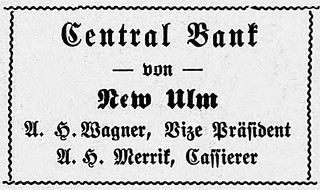 Some sources indicate that the banknotes of the Central Bank actually did enjoy a short-lived acceptance and heavy circulation within the St. Paul community, with most of the notes that survived showing heavy wear. However, the short-lived acceptance did not last … sometime during 1860, the Central Bank had been acquired by brothers Henry and John Jay Knox of St. Paul. The brothers established the J. Jay Knox and Co., and became a prominent banking establishment in St. Paul.
Some sources indicate that the banknotes of the Central Bank actually did enjoy a short-lived acceptance and heavy circulation within the St. Paul community, with most of the notes that survived showing heavy wear. However, the short-lived acceptance did not last … sometime during 1860, the Central Bank had been acquired by brothers Henry and John Jay Knox of St. Paul. The brothers established the J. Jay Knox and Co., and became a prominent banking establishment in St. Paul.
The Knox brother had big plans for the New Ulm Central Bank, but the Civil War greatly pressured bonds of the northern states in the early summer of 1861. Banknotes suffered serious losses and forced the failure of banks nationwide. This was also the tipping point for free banking in Minnesota. Also, the hope that the Minnesota 7s would find their footing was extinguished. Henry and John J. Knox saw the writing on the wall and gave up their effort to issue more notes and supporting the circulation of the notes of the New Ulm Central Bank. The New Ulm Central Bank banknotes were presented for redemption, but the Knox brothers refused payment, and the state forced the bank into liquidation. The state auditor sold the bonds on deposit for a deep discount, leaving only enough hard money (silver/gold) to pay holders 30 cents on the dollar for the New Ulm Central Bank banknotes. The weight of the financial crisis forced the closure of the New Ulm Central Bank. According to the New Ulm Pioneer (Pionier
) newspaper of July 6, 1861: The owners of the Central Bank of New Ulm, J. J. Knox & Co. of St. Paul closed their doors June 26th …
It also stated that they could not stand the run made on them caused by the absolute depreciation of all Northwestern paper money and they were forced to close their office. At the time of closure, the banknotes still in circulation amounted to a little over $5,000.00.
The banknotes issued by the New Ulm Central Bank were, like most banknotes of the time, beautifully ornate. All of the New Ulm Central Bank banknotes were printed by the American Bank Note Company who was a high security engraving and printing firm in the years prior to the Civil War. The company produced paper money, postage stamps, stock and bond certificates. All of the New Ulm Central Bank banknotes were only printed on one side, being blank on the back side, and only four denominations were issued: $1, $2, $5, and $10. The dimensions of these notes varied since they were cut down from sheets, but the average size was approximately 170mm x 71mm (6.7 inches x 2.8 inches). All of the banknote shown are examples of uncirculated, unsigned, and cancelled notes (as can be seen by the punch holes).
Forgive me for the early Christmas reference. Heck, some stores around here have had Christmas decorations on sale since before Halloween. -Editor
ONE DOLLAR BANKNOTE: New Ulm
is shown on the bottom center of the note. This is the only Minnesota banknote showing a Santa Claus vignette (ornamental illustration). Shows jovial Santa Claus seated in his sleigh with reindeer guiding him over the rooftop. The banknote also features, lower left, a portrait of Peter Stuyvesant, the last director-general of the colony of New Netherlands, now known as New York City. The tradition of Saint Nicholas … Santa Claus … Peter Stuyvesant go hand-in-hand, but not enough room here to elaborate. Peter Stuyvesant's portrait is also shown on different Santa Claus notes. It is said that the German heritage of New Ulm was undoubtedly a factor in the selection of these images on the note.
To read the complete article, see:
When New Ulm had its own money
(https://www.nujournal.com/life/lifestyle-feature/2021/11/20/when-new-ulm-had-its-own-money/)
ZIMBABWE HUSTLERS TRADE TATTERED US NOTES
The Guardian published an article on Zimbabwe street hustlers trading in tattered US notes. -Editor
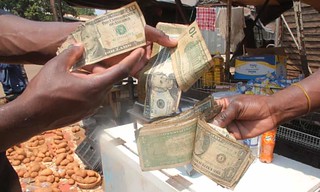 In time-honoured street hawker tradition, Kaitano Kasani is using charm and persuasion to get people to sell him their tattered US banknotes.
In time-honoured street hawker tradition, Kaitano Kasani is using charm and persuasion to get people to sell him their tattered US banknotes.
Kasani, 42, bellows through a megaphone as he walks through Glen Norah, a township in Harare, in the sweltering November heat.
Bring all your old and torn notes. I have a good rate today. There is no other better deal in town,
Kasani shouts.
A woman brings a torn $20 note (£15) which Kasani inspects before handing her $15.
In Zimbabwe's beleaguered economy, buying and selling half-shredded banknotes has become the latest hustle.
Zimbabweans are suspicious of banks and prefer to keep their money under pillows and beds. In previous crises, hyperinflation wiped out millions in savings, particularly in 2008. Now, there is a lack of favoured banknotes as they wear out faster than replacements come into circulation.
Shortages have led to the government telling banks and retailers not to reject old or worn US dollars, but many defy the order. A lack of exports means fewer new notes in circulation, and Zimbabweans are re-using increasingly grubby notes. Dealers either mend them or sell them on to others who will bribe or otherwise persuade senior bank officials to exchange large quantities.
These torn notes are more valuable to me than new ones. These old notes, when taken to the bank, will be replaced at the same value, yet we would have bought them at nearly half the original value, depending on how bad they are,
says Kasani.
All I need is the serial number and the necessary features for me to take.
Kasani sells old notes to business people and other cash dealers at 80% profit.
His new business has sustained his four children after he lost his job in manufacturing two years ago.
To read the complete article, see:
Dirty dollars: how tattered US notes became the latest street hustle in Zimbabwe
(https://www.theguardian.com/global-development/2021/nov/17/dirty-dollars-how-tattered-us-notes-became-the-latest-street-hustle-in-zimbabwe)
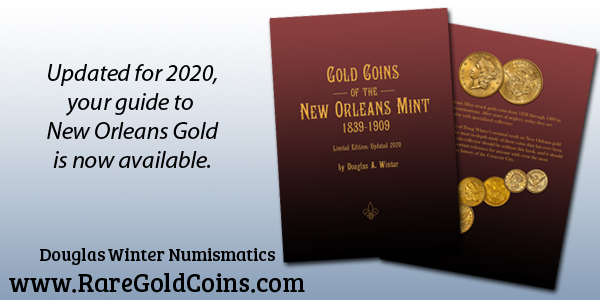
LOOSE CHANGE: NOVEMBER 21, 2021
Here are some additional items in the media this week that may be of interest. -Editor
An article by Tyler Rossi for CoinWeek discusses ancient Chinese coins and the world's oldest mint. Thanks to Arthur Shippee for passing this along from The Explorator newsletter. -Editor
In early August 2021, Han Zhao and his team of Chinese archaeologists with the State University of Zhengzhou, announced that they had discovered the world's oldest coin mint
. Located near the city of Xingyang in the Henan province in central China, the physical archaeological evidence and radiocarbon dating places the facility's minting operations to between 640 and 550 BCE. This was during China's Spring and Autumn Period (770–476 BCE).
The facility began operations in 770 BCE, not with the production of coins but with the production of valuable bronze, ceramic, jade and bone artifacts
, only shifting focus to striking coins around 640 BCE.
To read the complete article, see:
Ancient Chinese Coins and the World's Oldest Mint
(https://coinweek.com/ancient-coins/ancient-chinese-coins-and-the-worlds-oldest-mint/)
Armored vehicle mishaps don't happen very often, but when they do they always make the news. Here's the latest incident, from California. -Editor
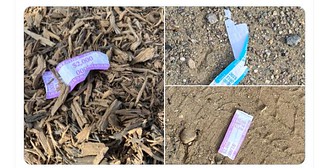 An armored vehicle has lost a large number of banknotes on a highway in the US state of California. Motorists stopped in the middle of the road to fill their pockets with leftover money.
An armored vehicle has lost a large number of banknotes on a highway in the US state of California. Motorists stopped in the middle of the road to fill their pockets with leftover money.
The big grab
began after the door of a cash truck opened near San Diego on Interstate 5. Thousands of dollars flew in various categories from the cash truck. Videos posted on social media show people walking down the street, taking money and throwing up a handful of dollars in celebration.
Two people have already been arrested: a man and a woman collecting their share of free money and accidentally locking themselves out of their car. They blocked the road and were allowed to go with the police, unable to leave the place.
To read the complete article, see:
Confusion on the American highway due to the loss of banknotes
(https://www.taylordailypress.net/confusion-on-the-american-highway-due-to-the-loss-of-banknotes/)

JERUSALEM WOMAN MICROWAVES RENT MONEY
I haven't seen a story like this since early in the pandemic. Afraid of COVID, a woman in Jerusalem destroyed banknotes in a microwave. -Editor
An elderly woman has microwaved over NIS 10,000 in rent money in an attempt to disinfect them from COVID-19, it emerged Thursday.
The 74-year-old Jerusalem resident said that she has been doing so as to avoid coronavirus.
"This week I collected all the banknotes in the amount of thousands of shekels," she wrote to the Bank of Israel.
"Fearing coronavirus, I touched banknotes with gloves and in my naivety I put them in a plastic bowl with bleach and heated them in the microwave to disinfect them. I left the kitchen and immediately came back smelling something burnt and the money burned.
The case was transferred to the Bank of Israel's Currency Department for investigation, and that the appellant was reimbursed the full sum.
To read the complete article, see:
Elderly woman microwaves over NIS 10,000 in rent money fearing COVID
(https://www.ynetnews.com/article/bynvs5muy)

